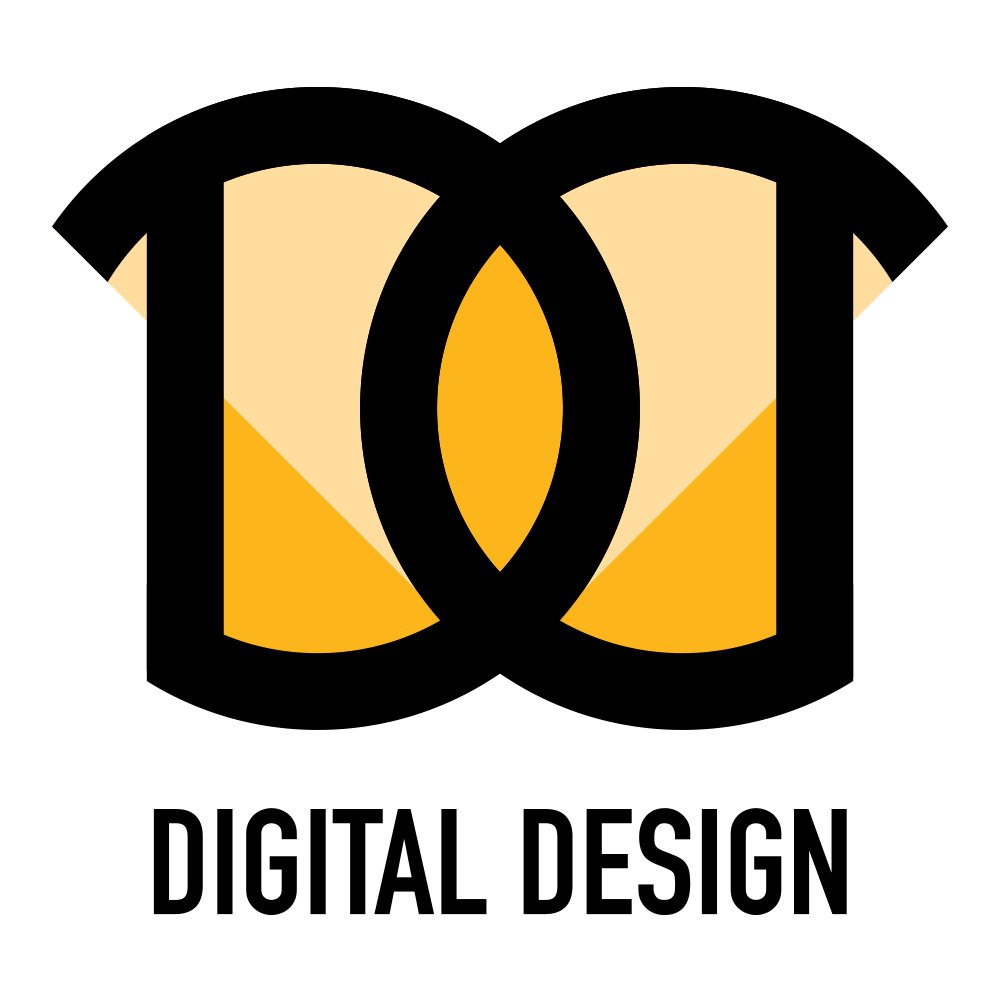UI Design, BRANDING

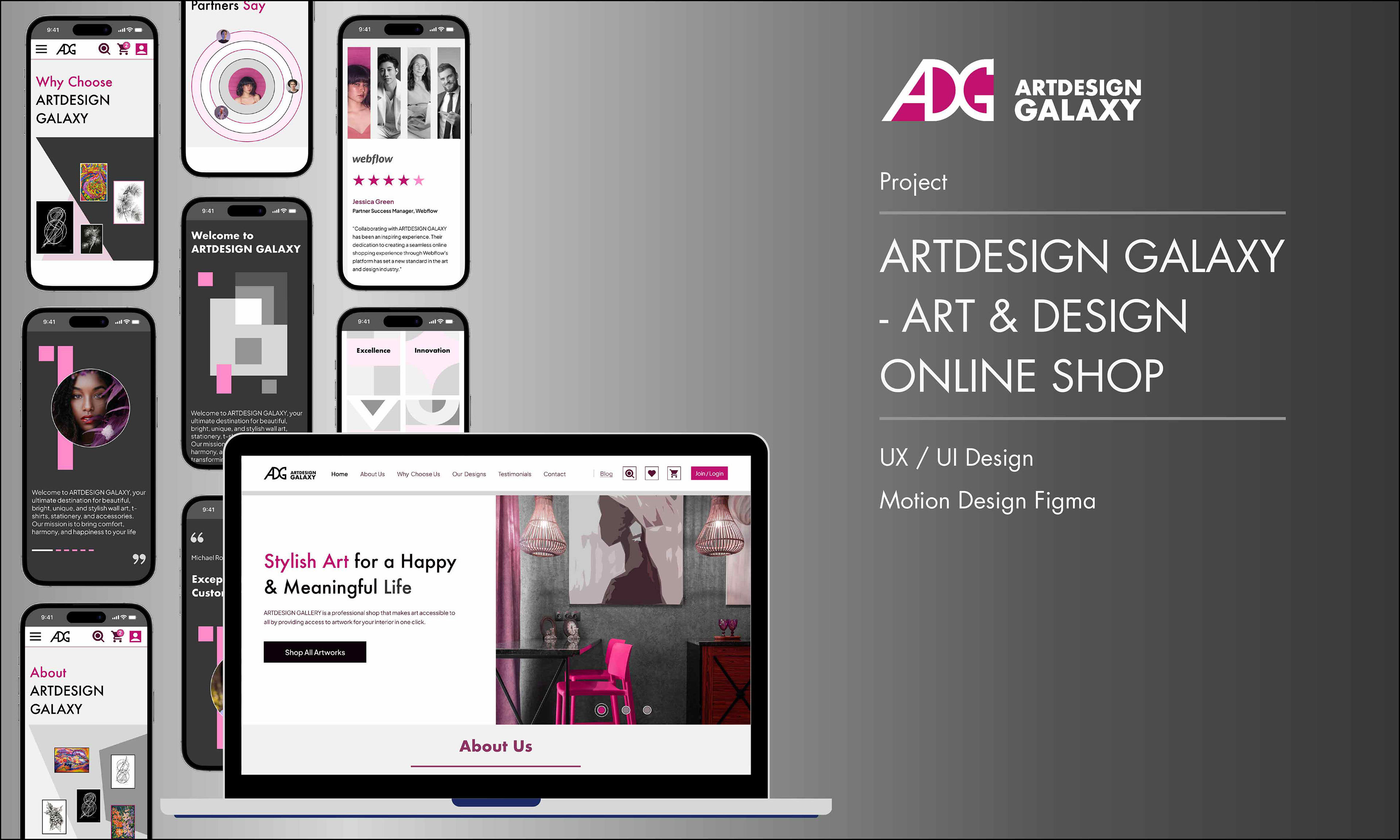
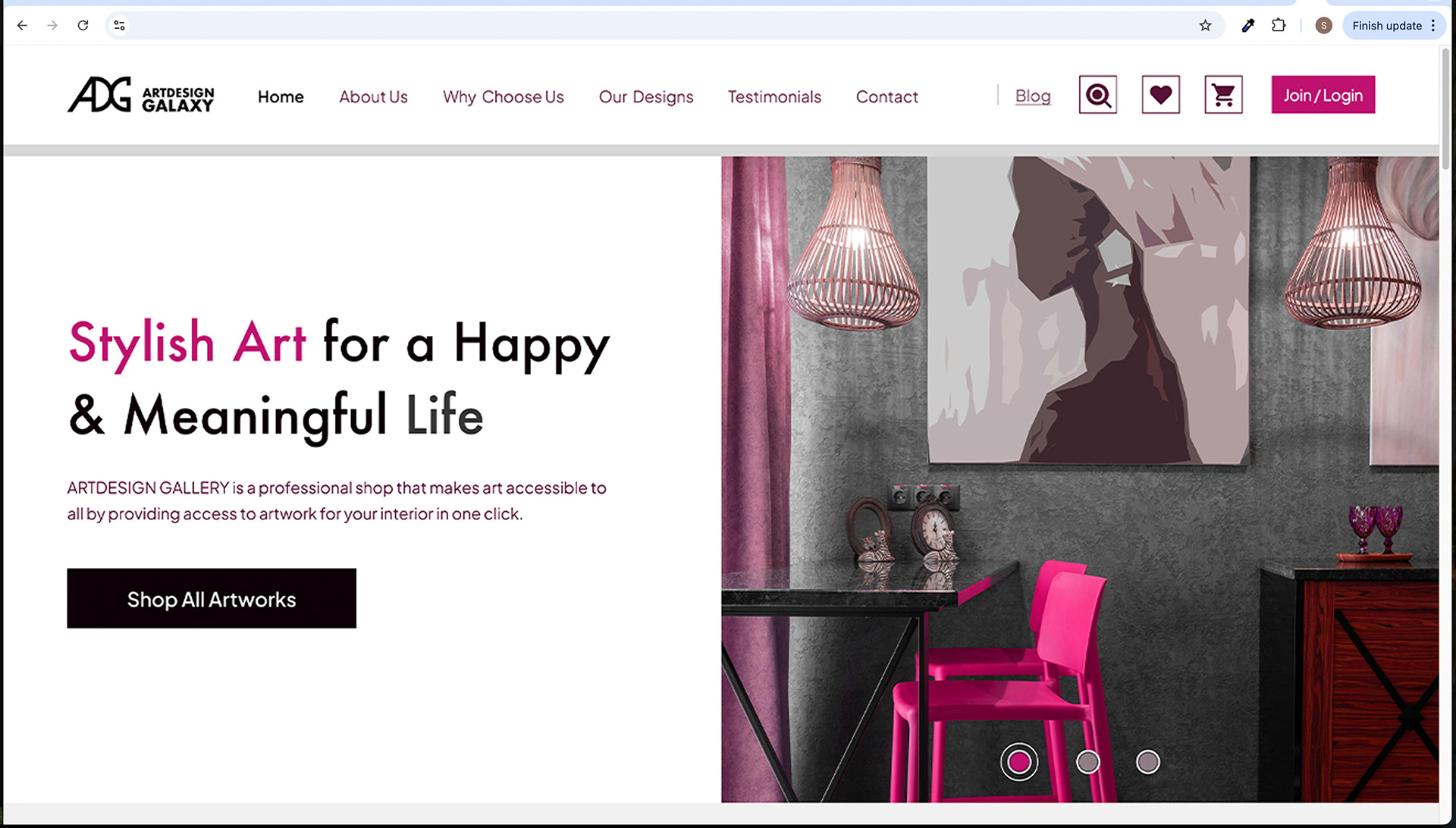
Home Screen
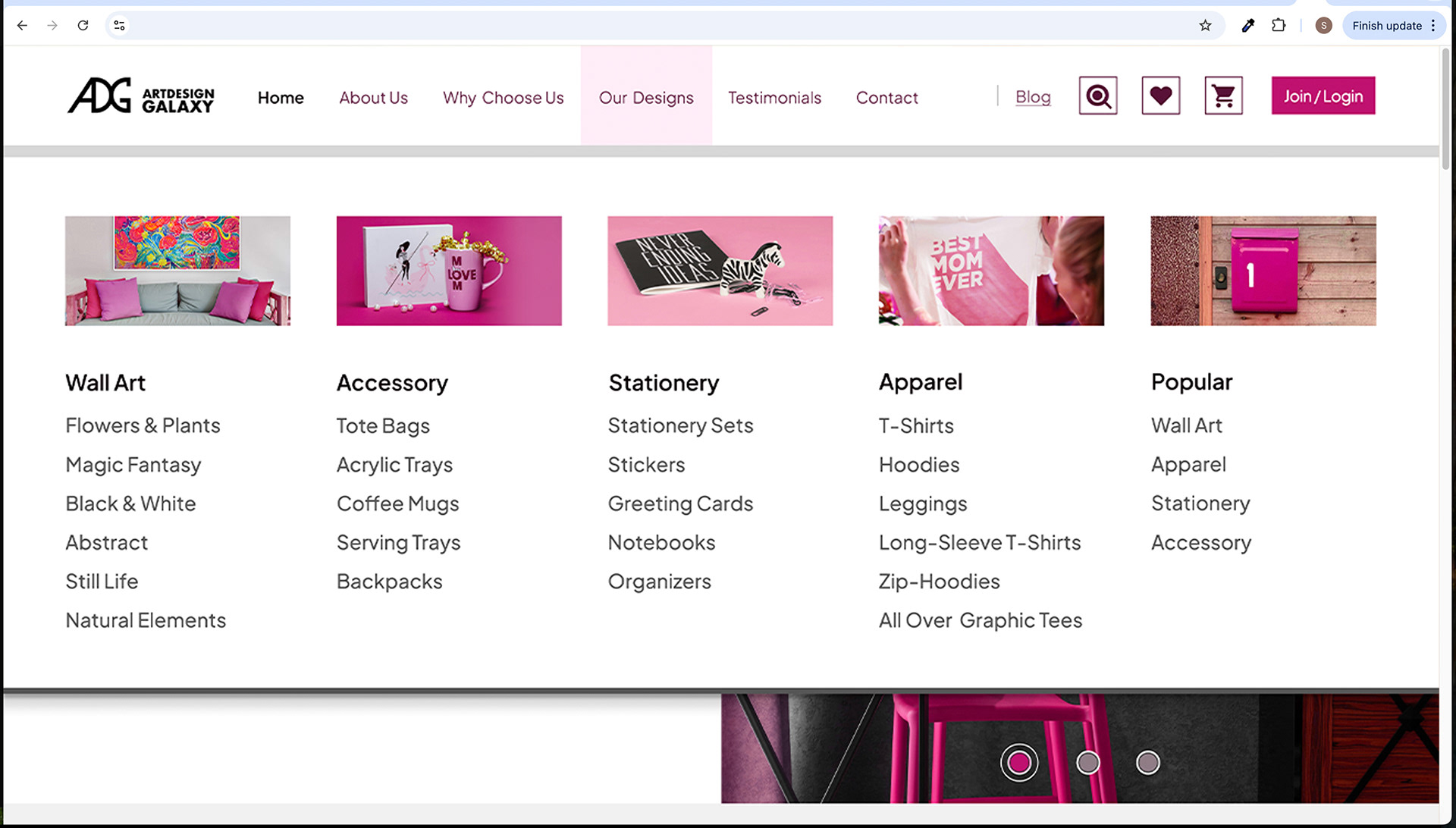
Home Screen - Mega Menu
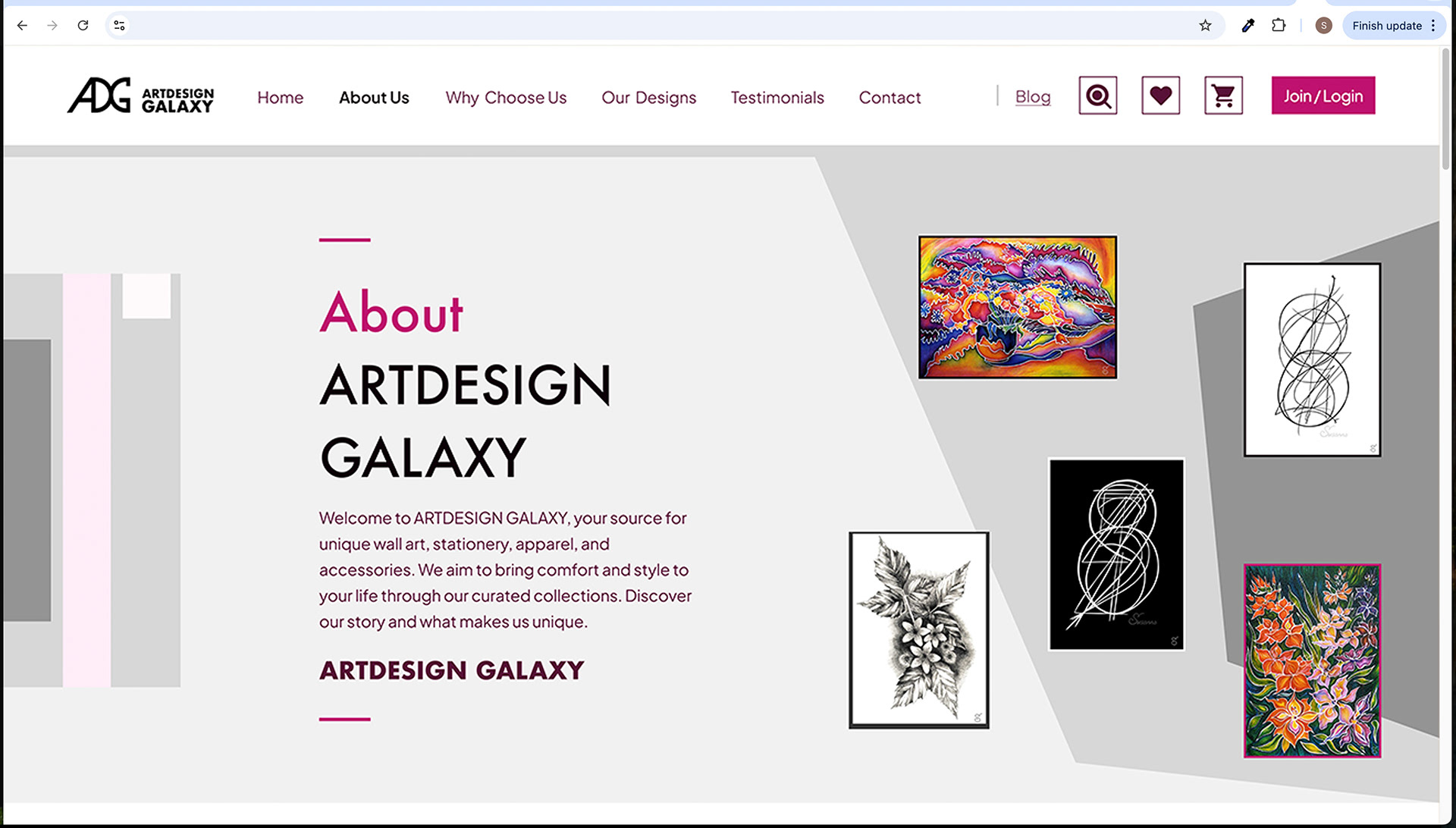
About Us Screen

Why Choose Us Screen
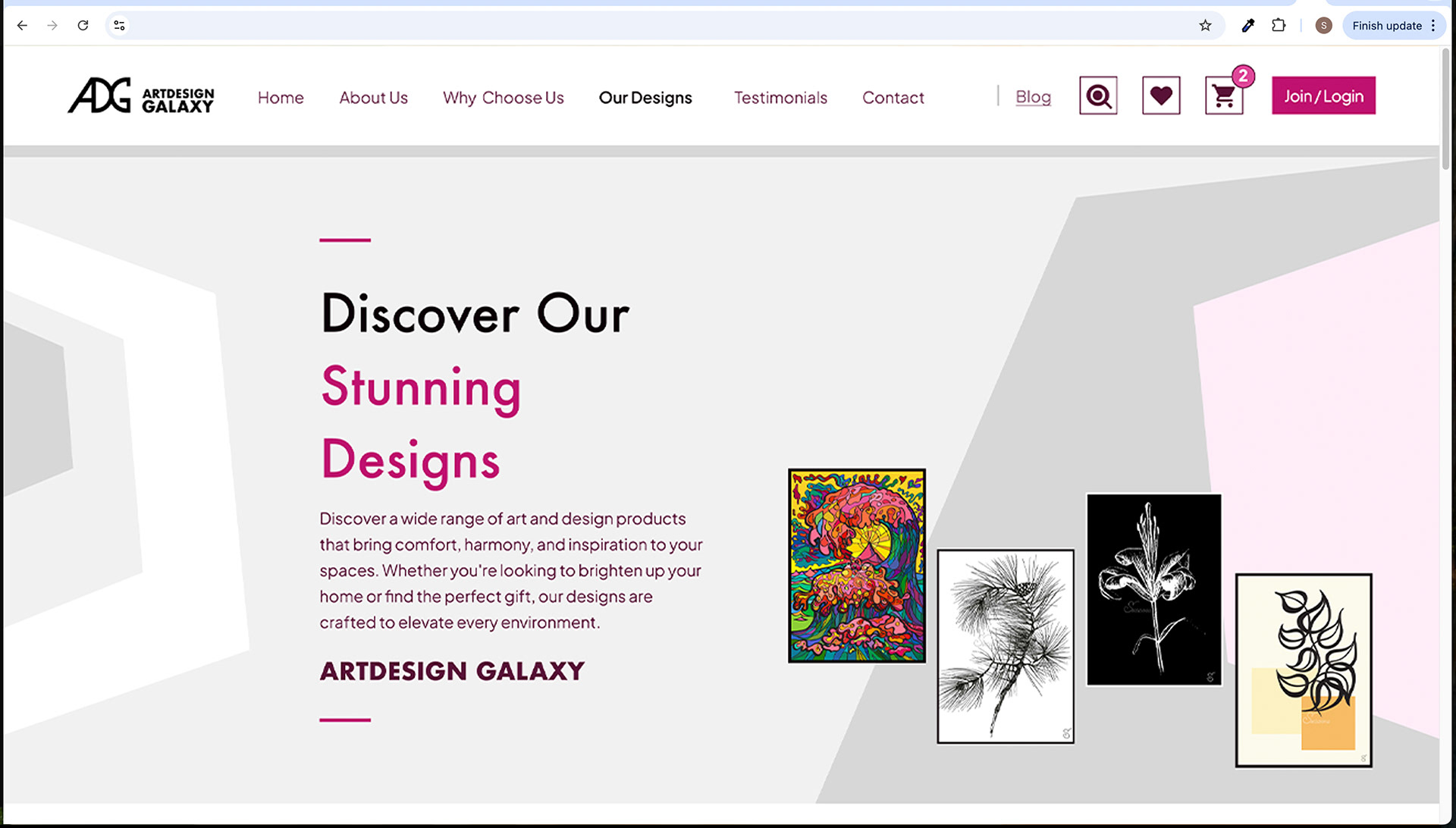
Our Designs Screen
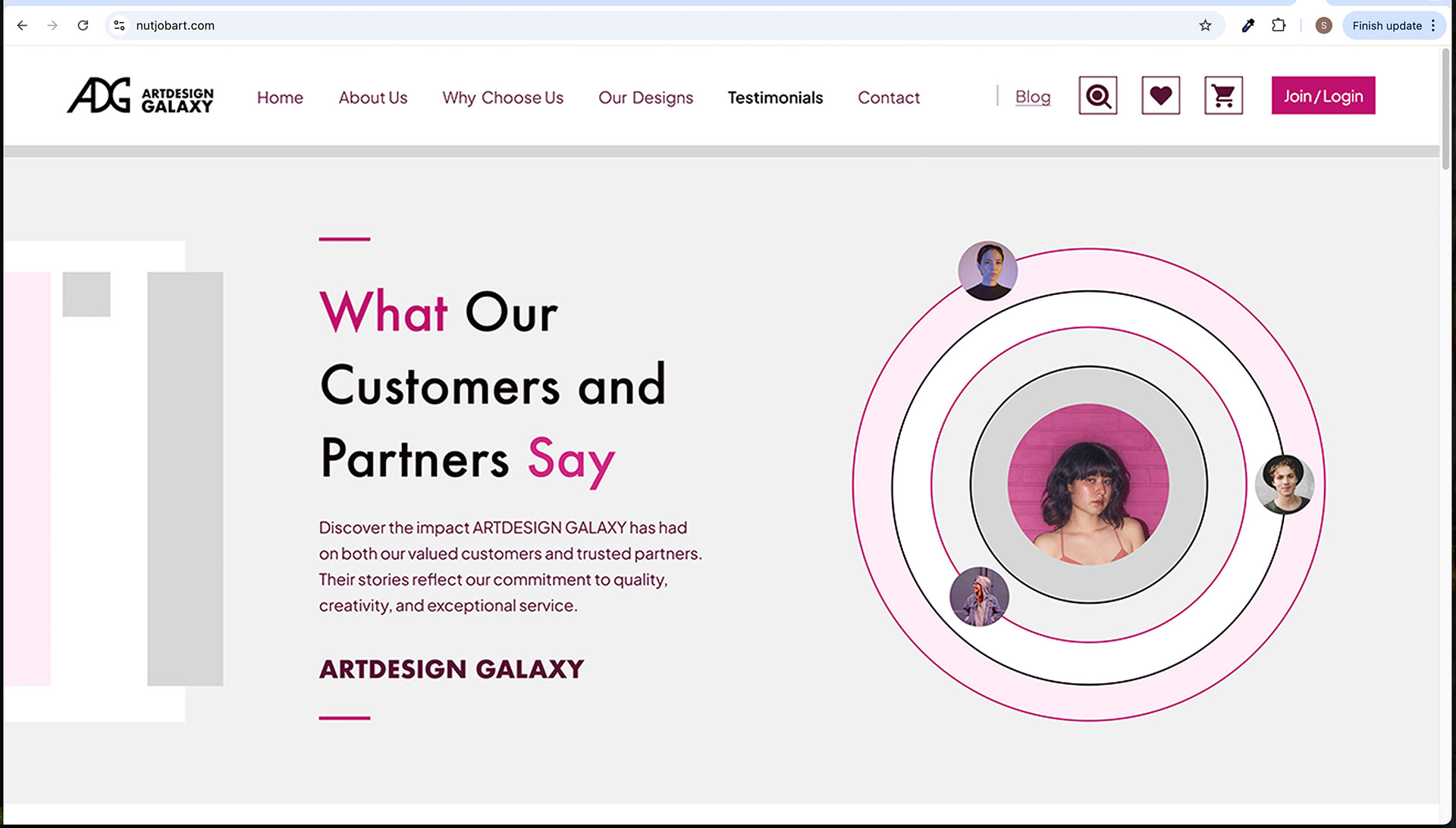
Testimonials Screen
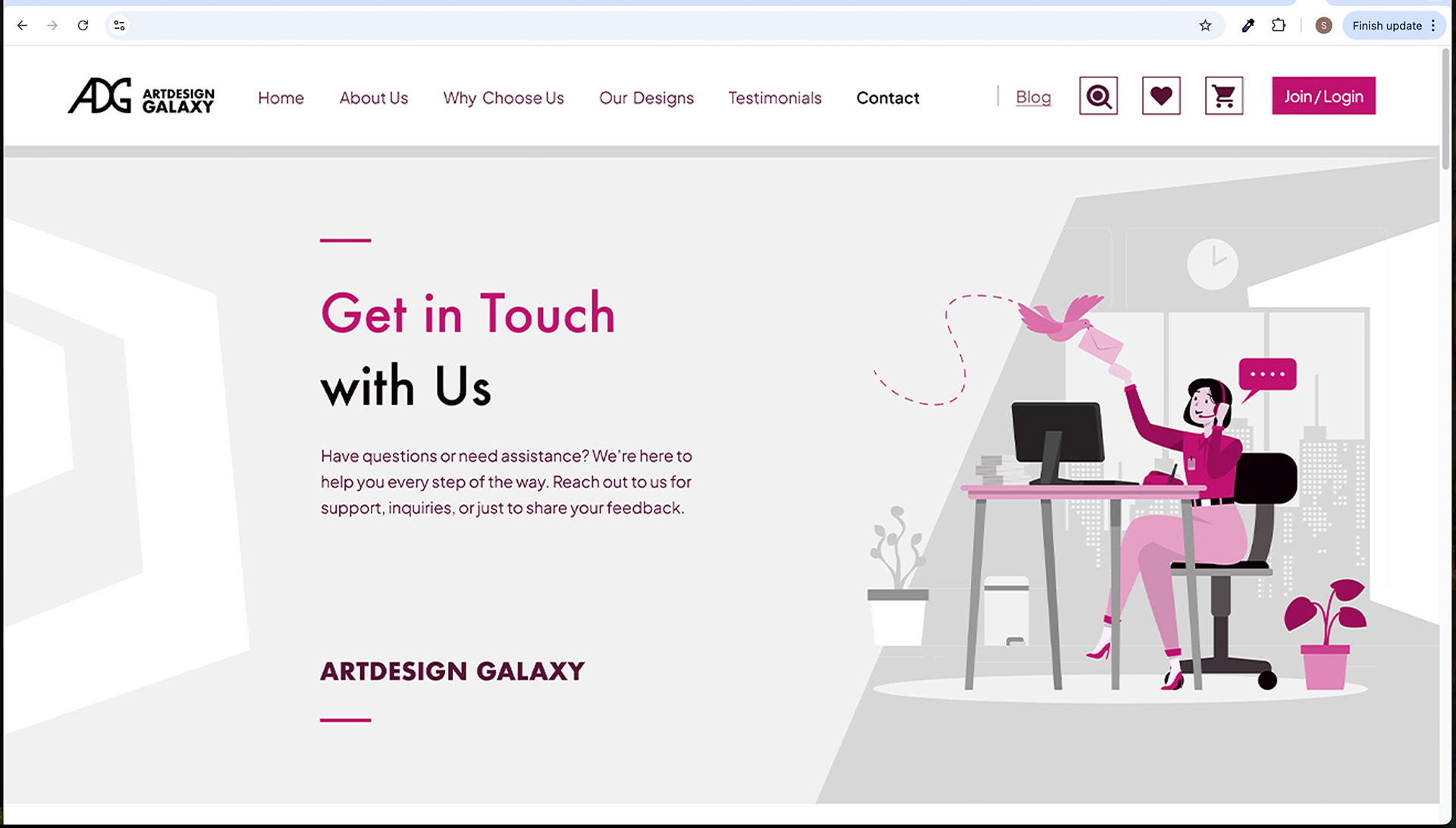
Contact Screen

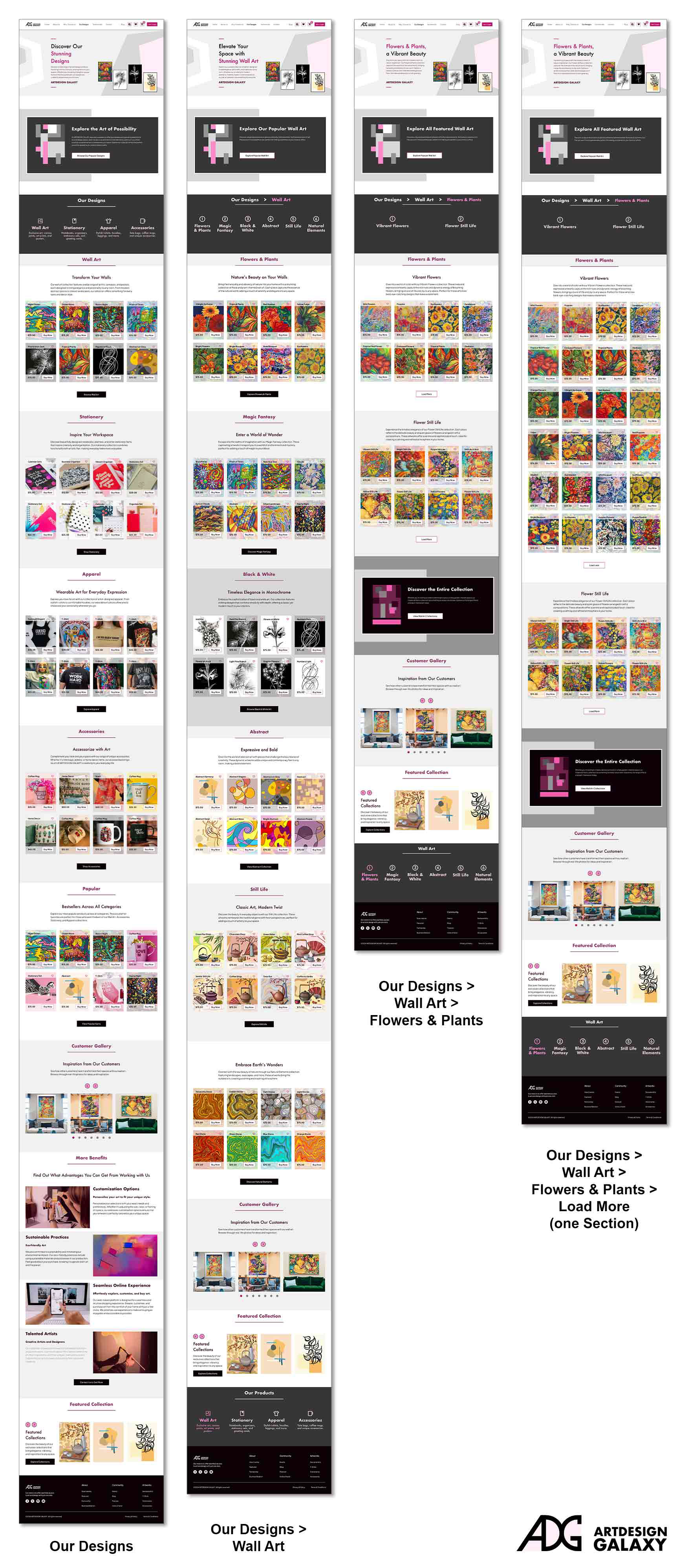
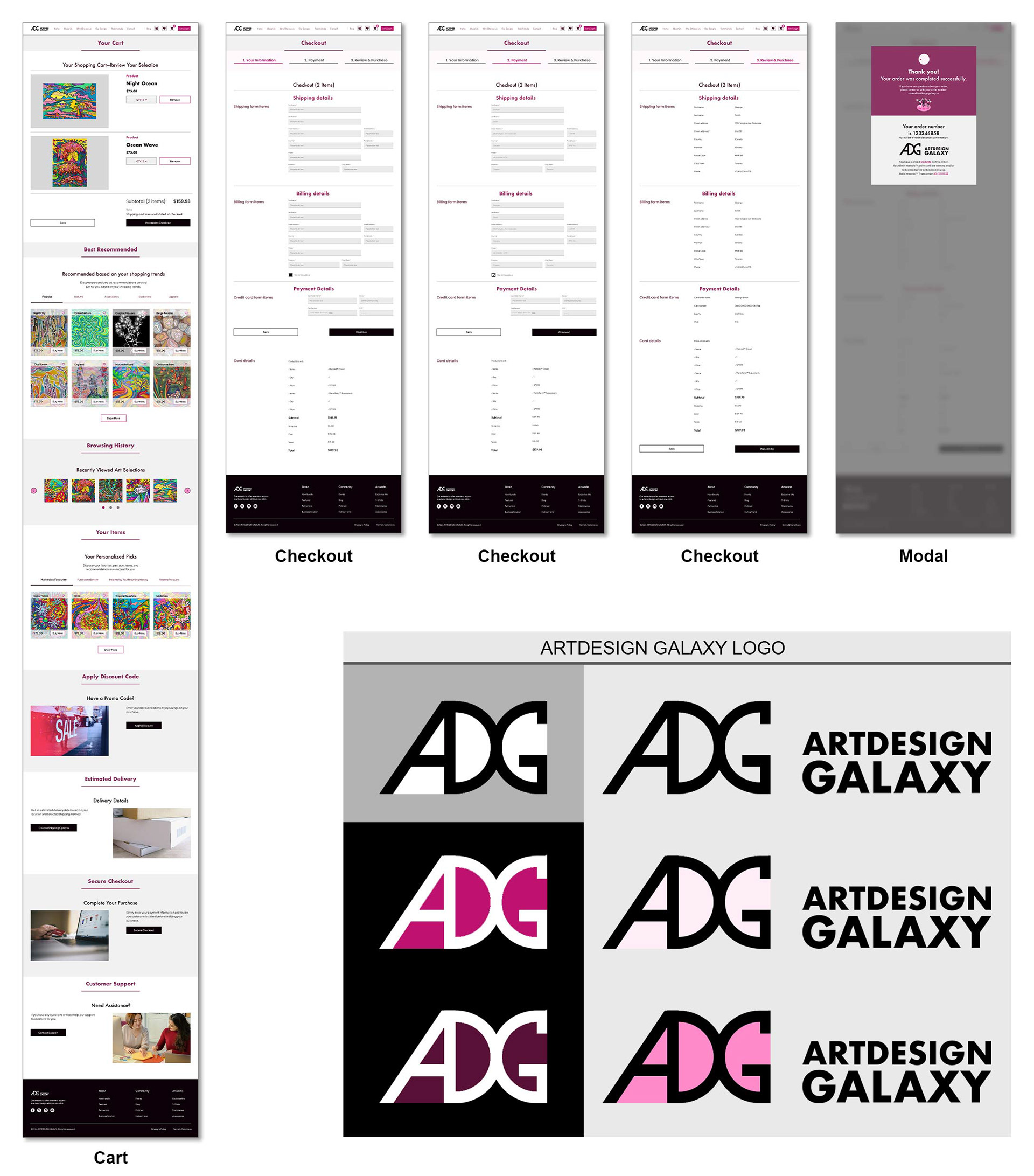



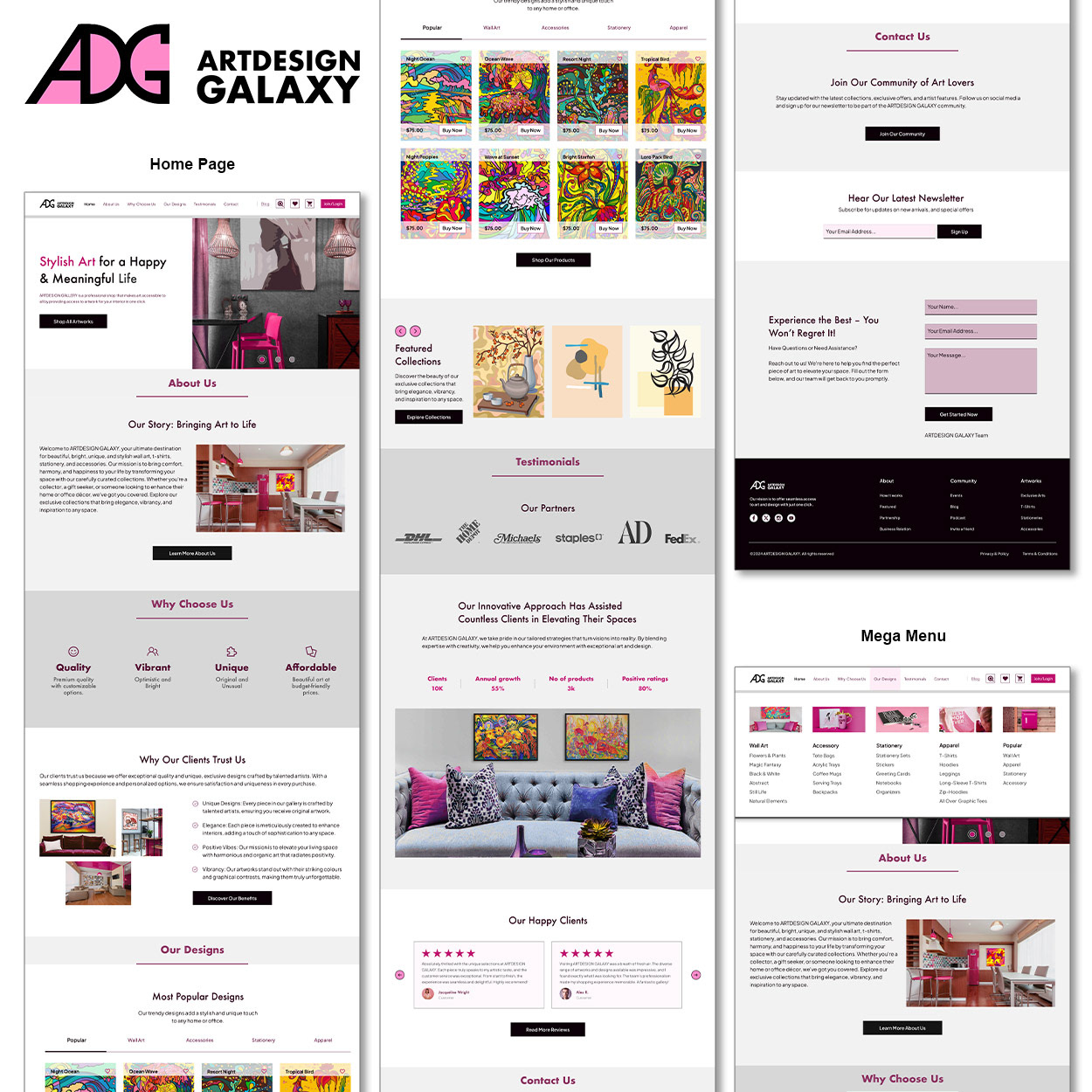
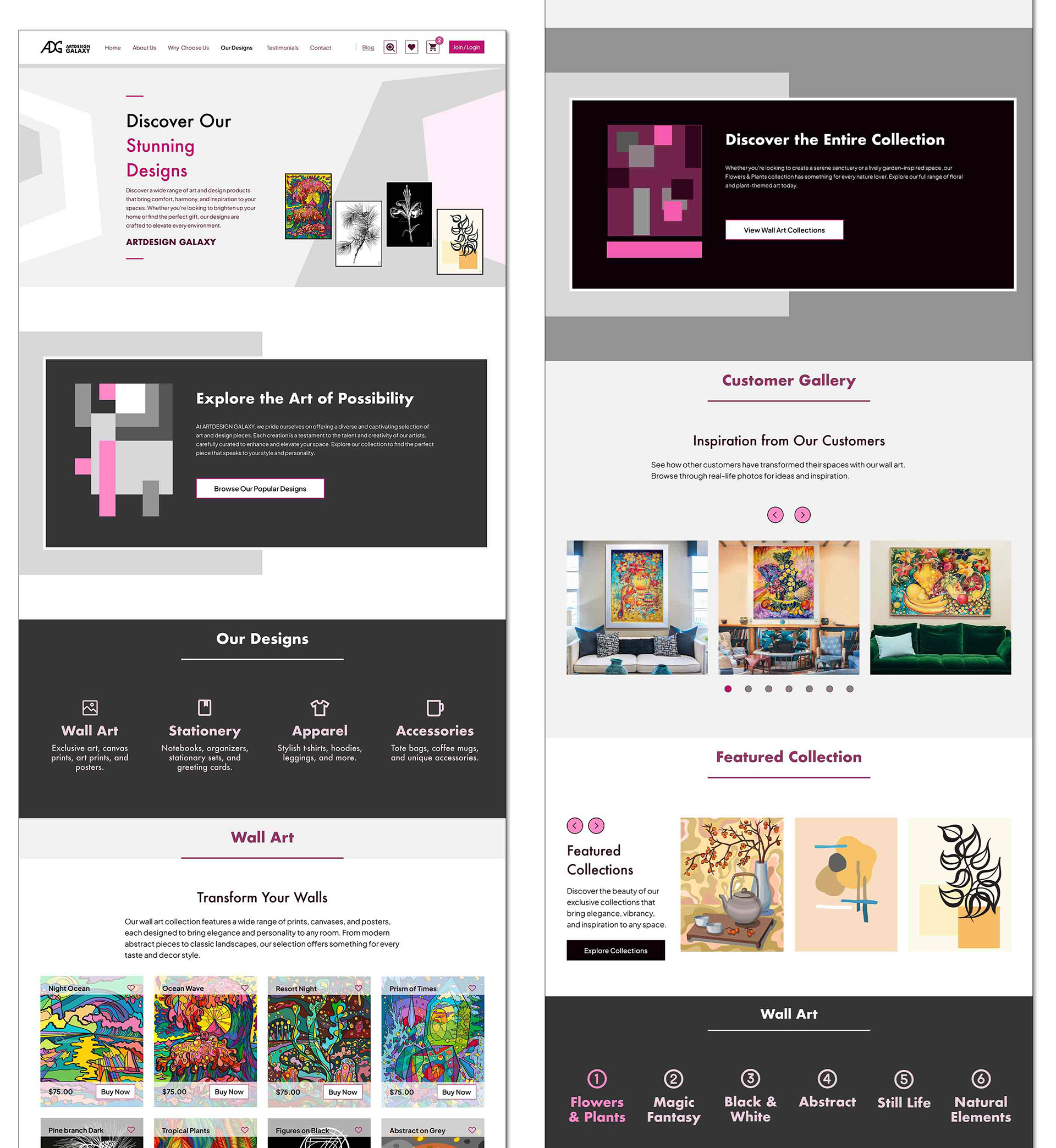

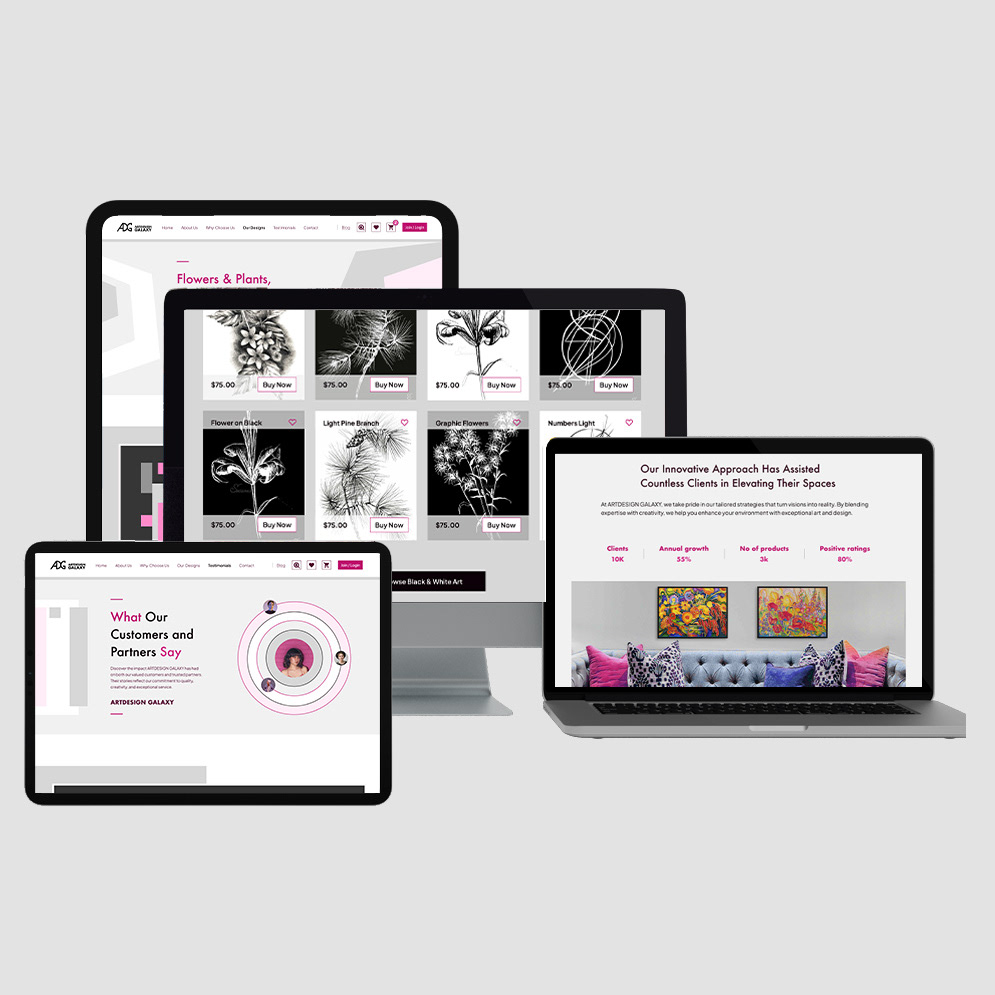
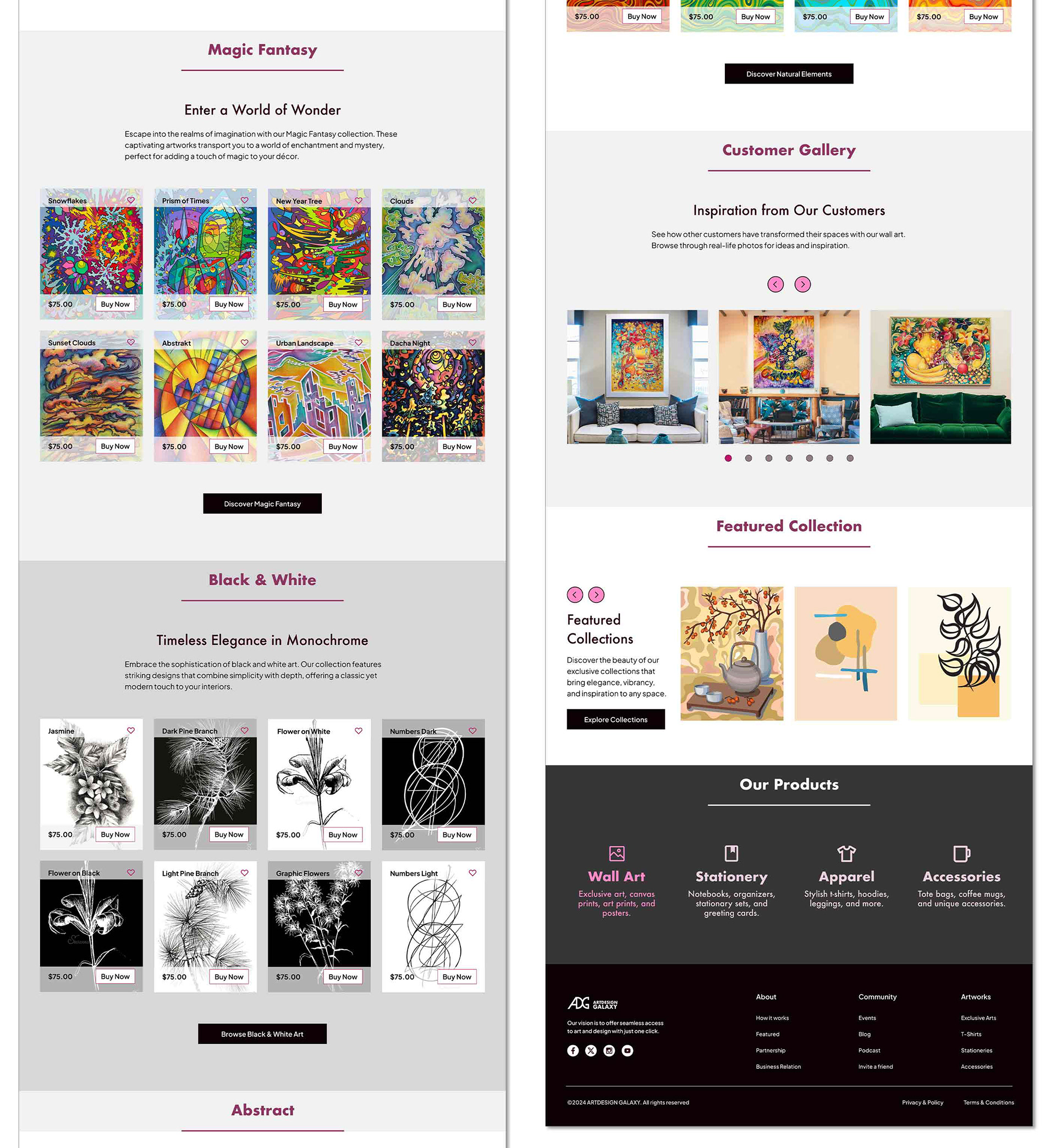

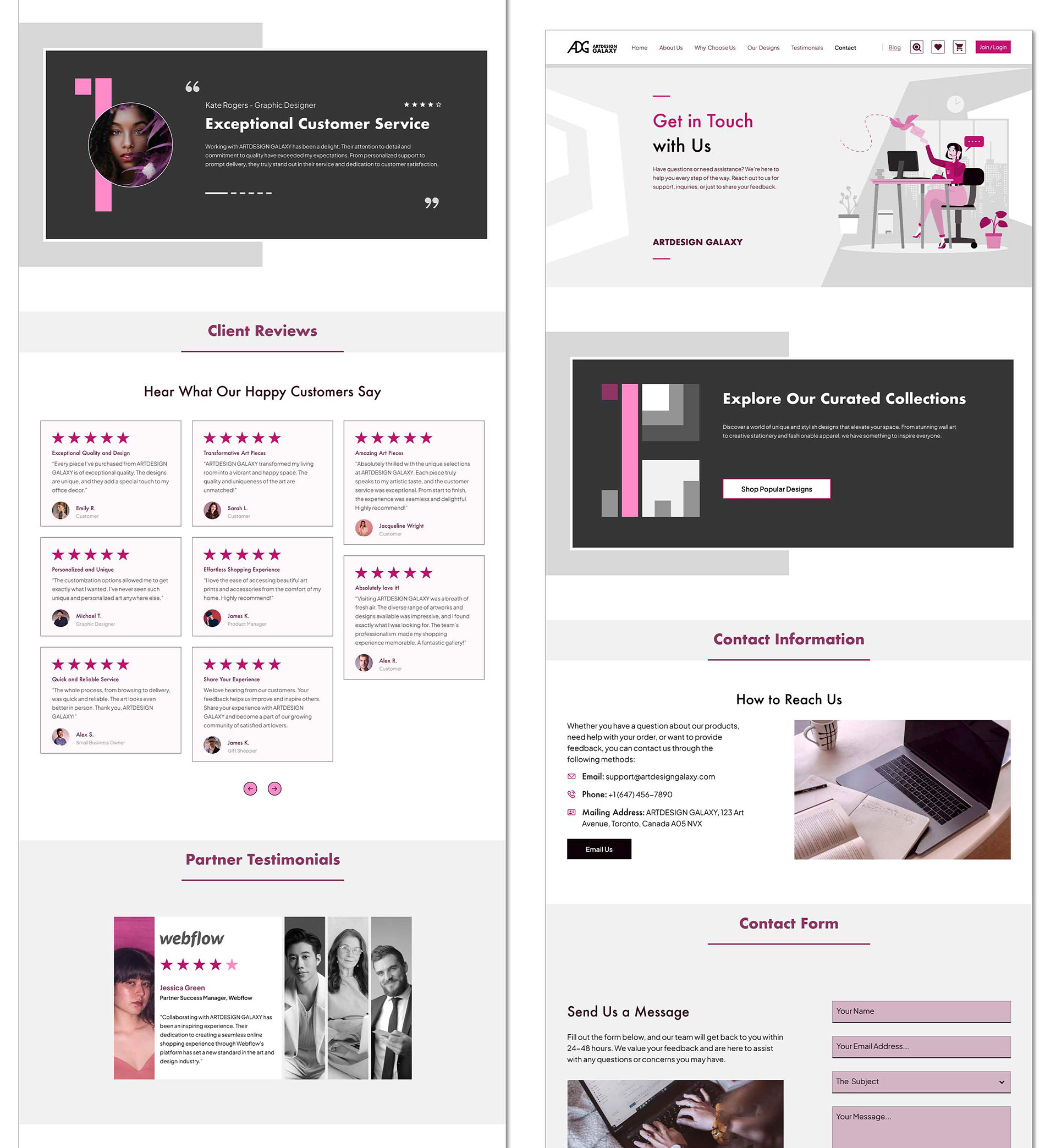
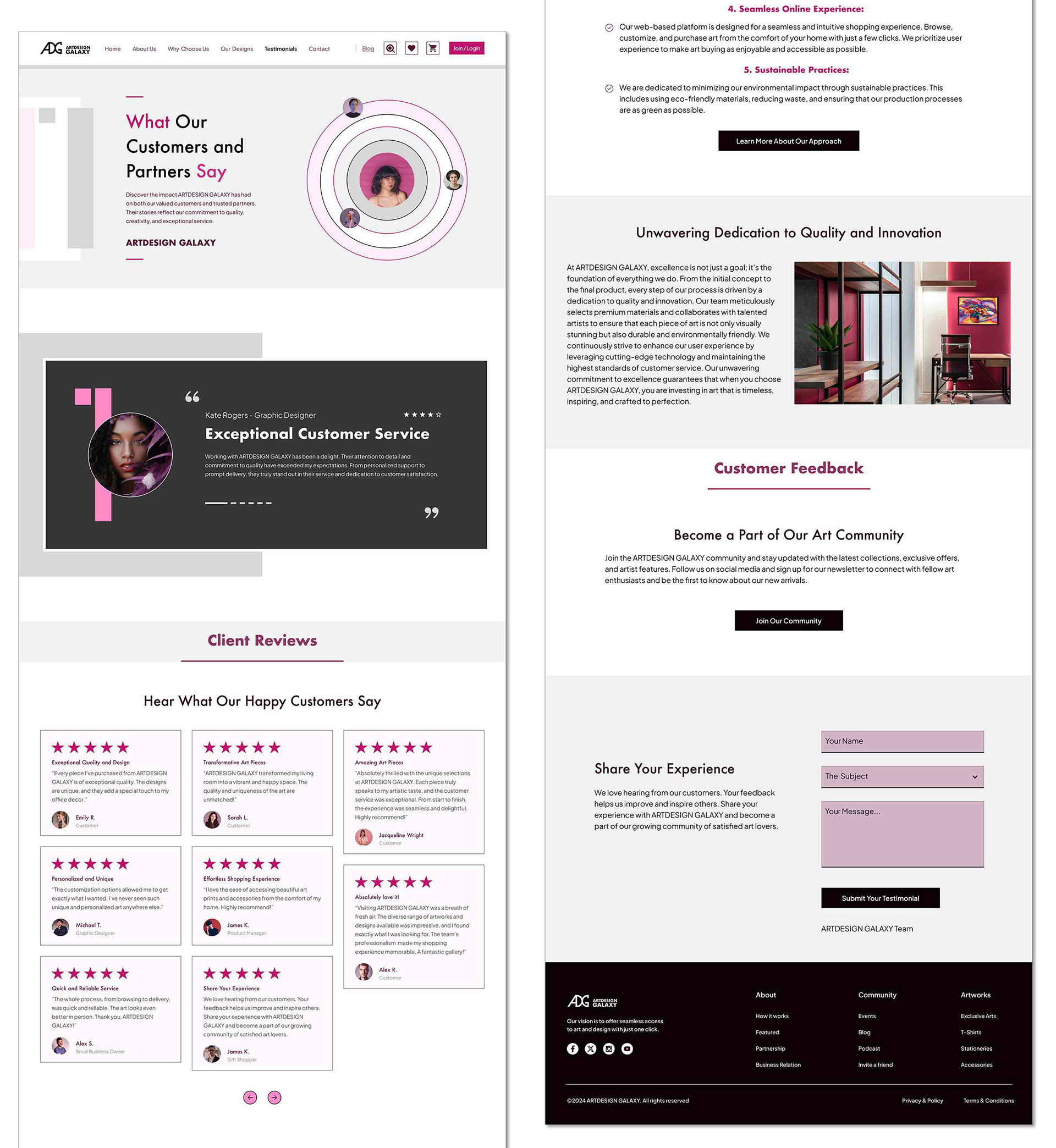

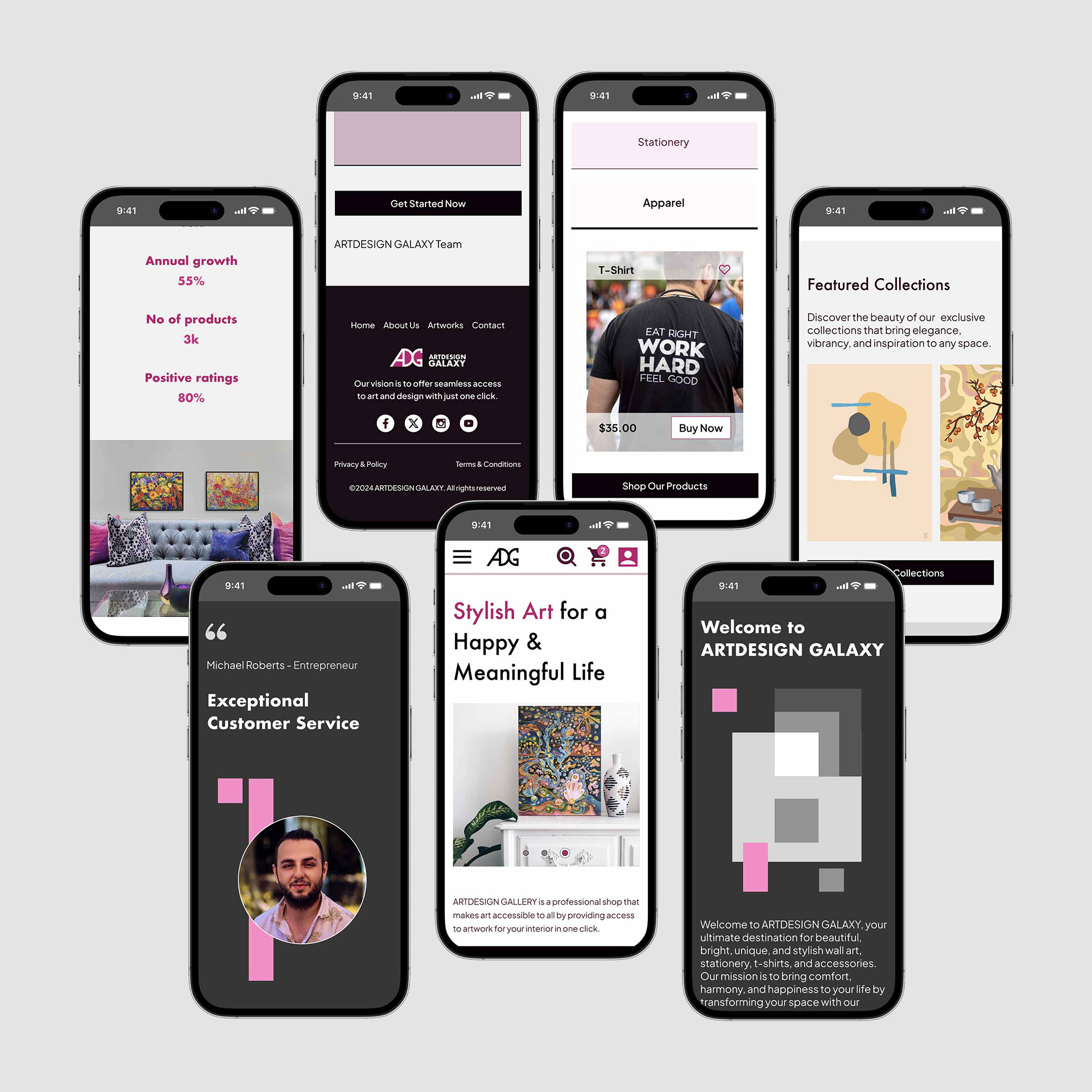
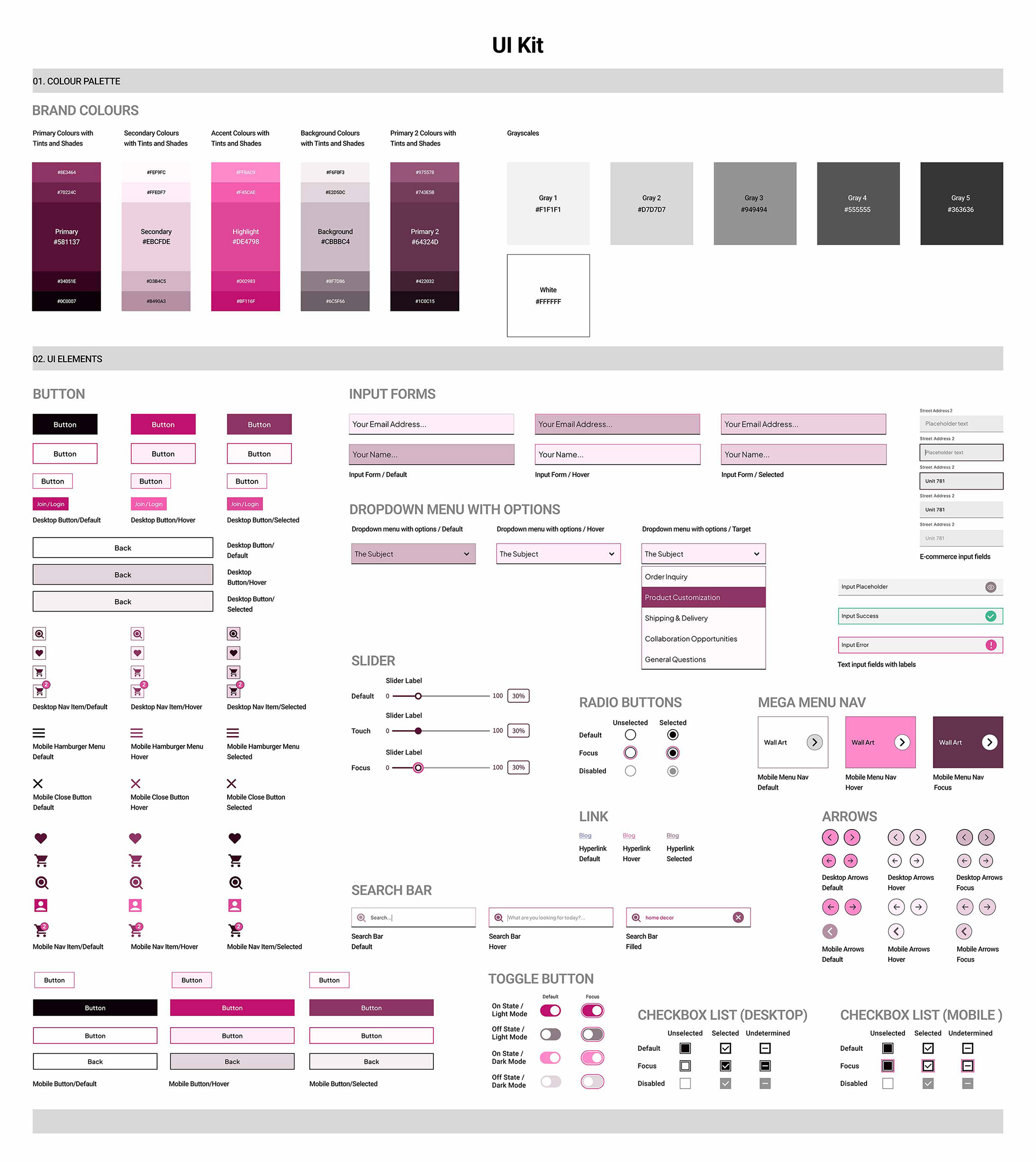
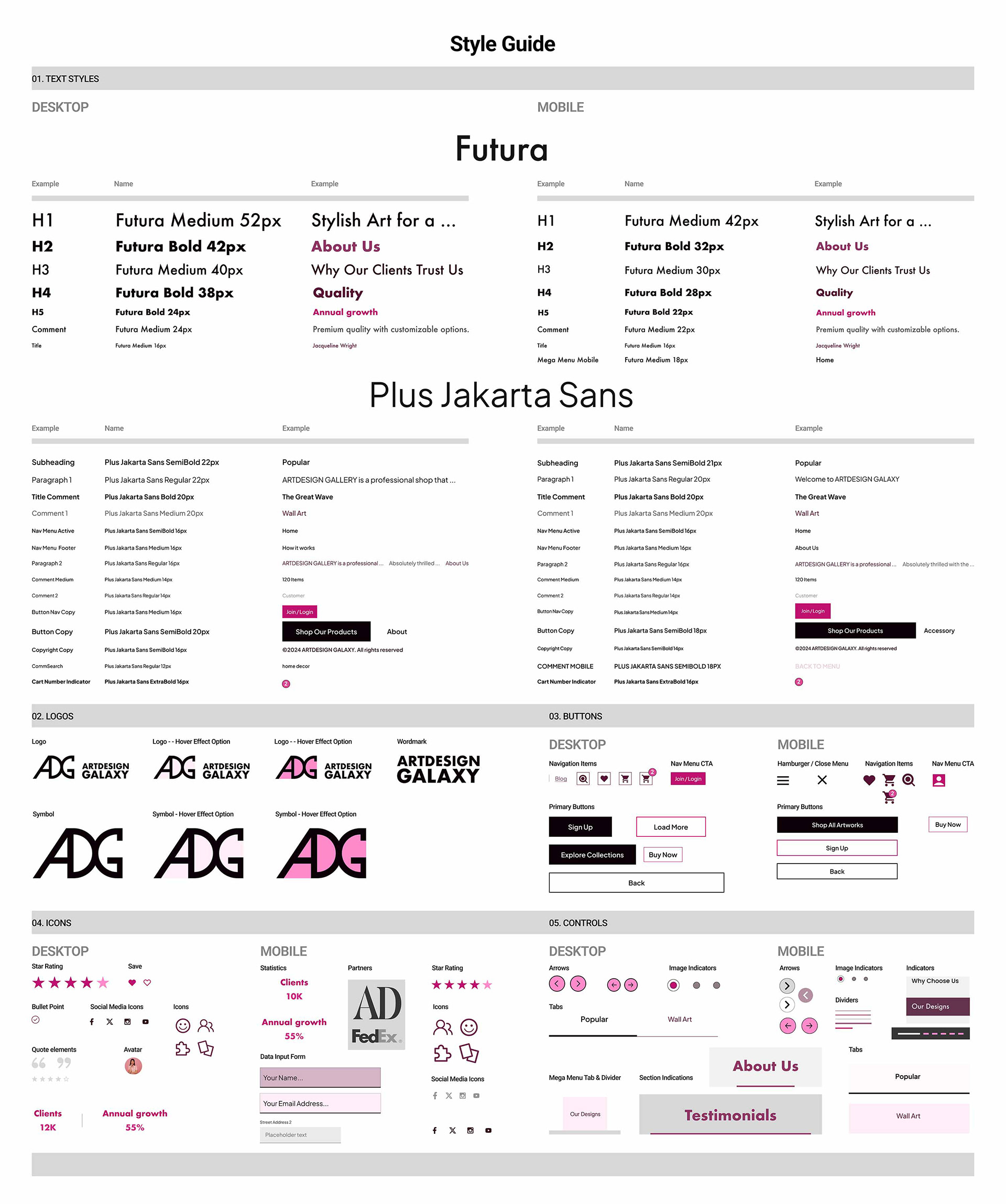

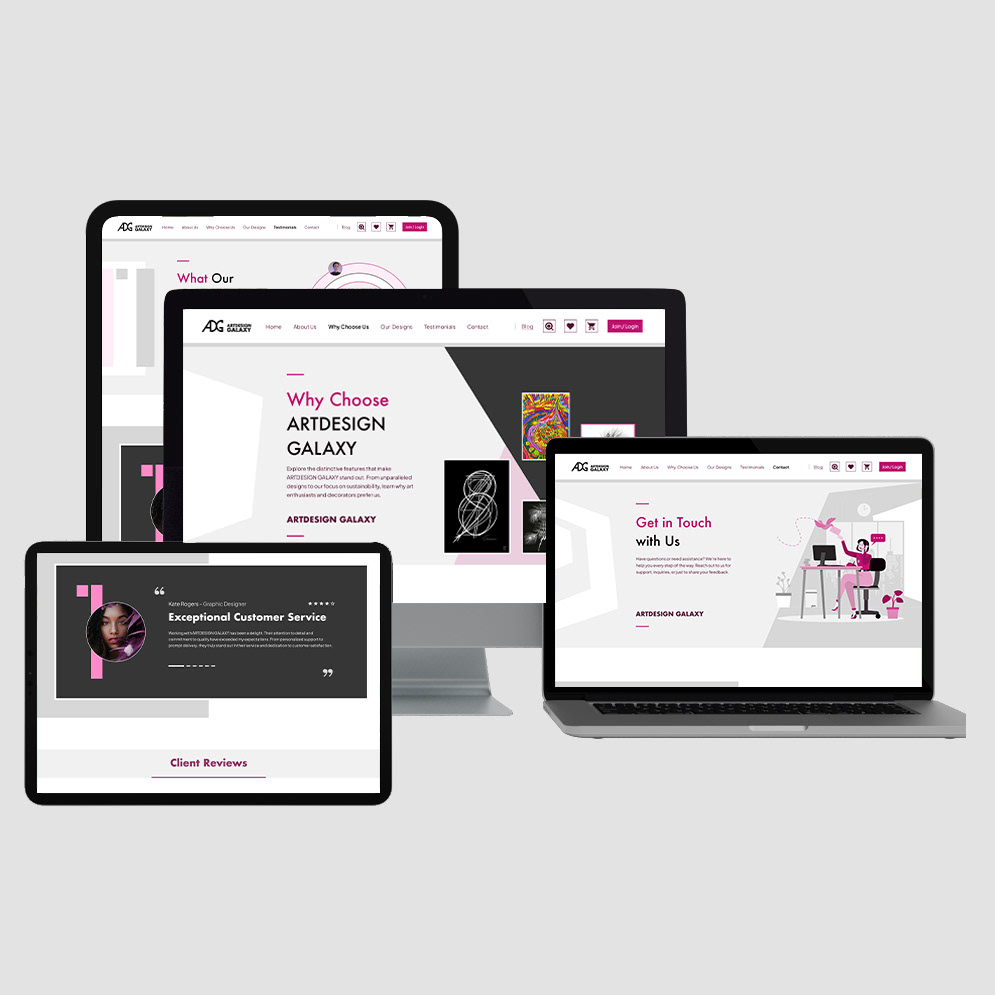
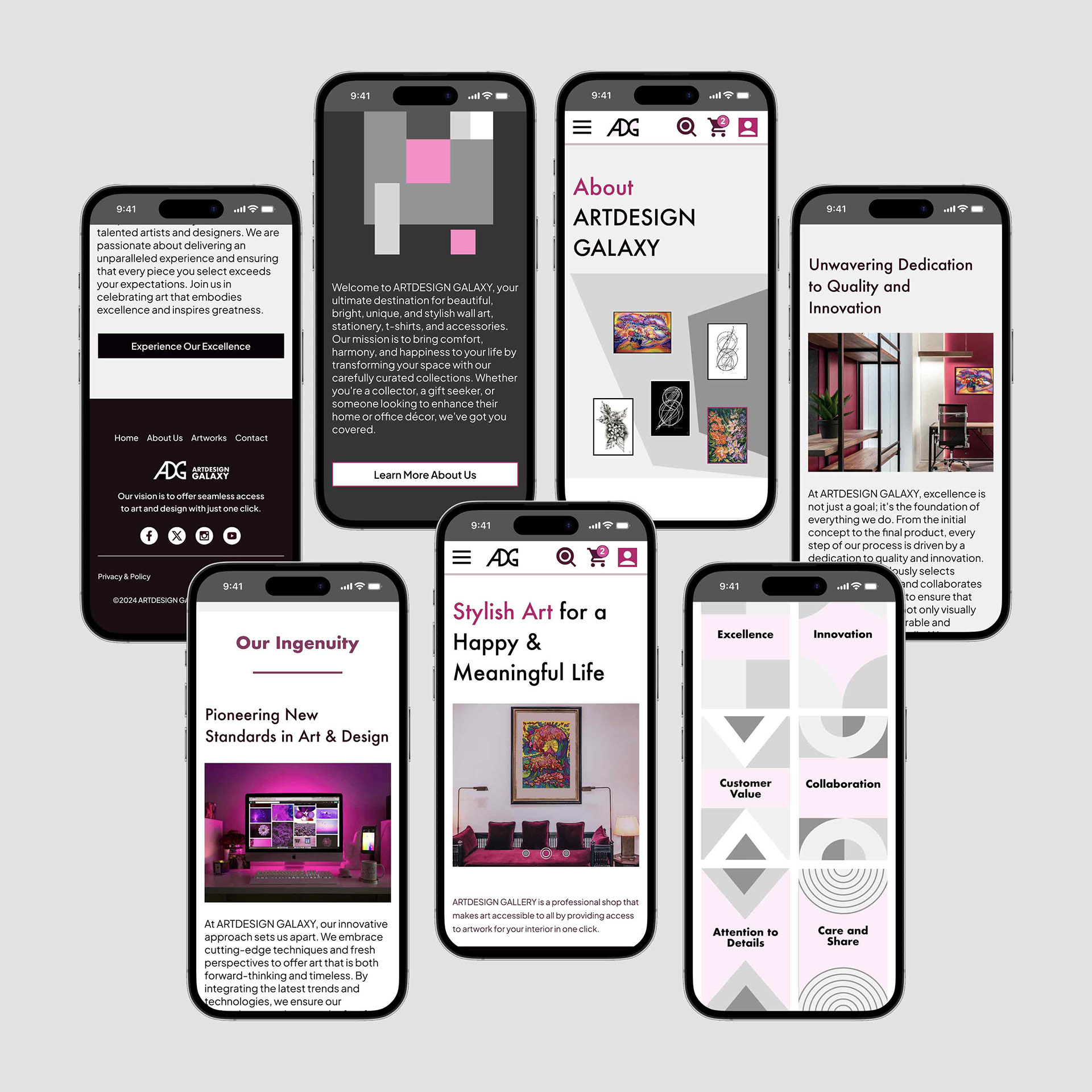
ARTDESIGN GALAXY - Art & Design Online Shop
CLICKABLE PROTOTYPE
Copy the Link & View the Clickable Figma DESKTOP Prototype ARTDESIGN GALAXY - Art & Design Online Shop with Animation:
https://www.figma.com/proto/JxTouESAf3HgyYGsGZOrL0/ARTDESIGN-GALAXY-website?node-id=2107-3729&t=GWF9BzrgCk4J4BL9-0&scaling=scale-down-width&content-scaling=fixed&page-id=1%3A2865&starting-point-node-id=2107%3A3729&hide-ui=1
Copy the Link & View the Clickable Figma MOBILE Prototype ARTDESIGN GALAXY - Art & Design Online Shop with Animation:
https://www.figma.com/proto/JxTouESAf3HgyYGsGZOrL0/ARTDESIGN-GALAXY-website?node-id=6179-39484&t=GWF9BzrgCk4J4BL9-0&scaling=scale-down&content-scaling=fixed&page-id=2187%3A14152&starting-point-node-id=6179%3A39484&hide-ui=1
UX DESIGN
ARTDESIGN GALAXY - Art & Design Online Shop
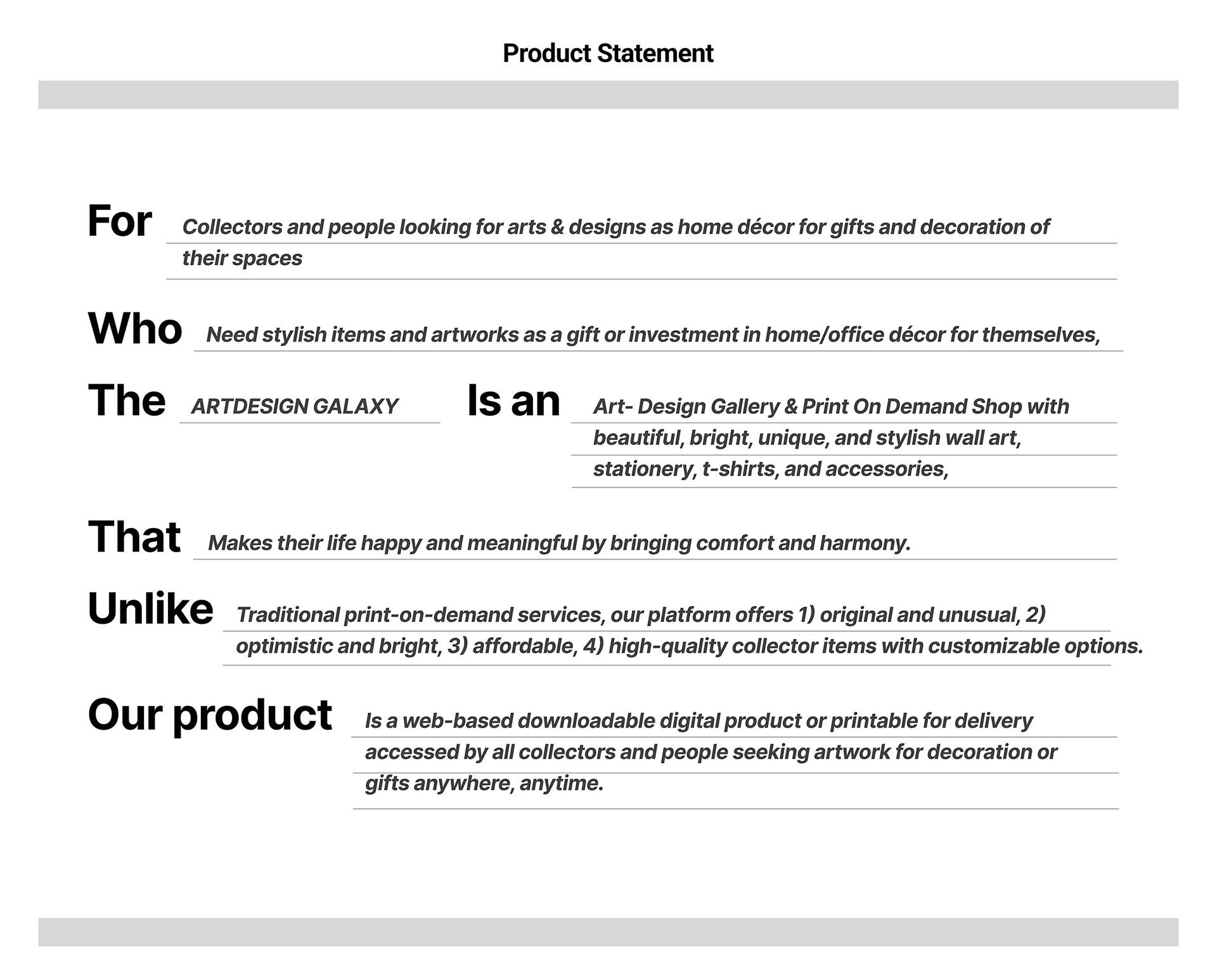

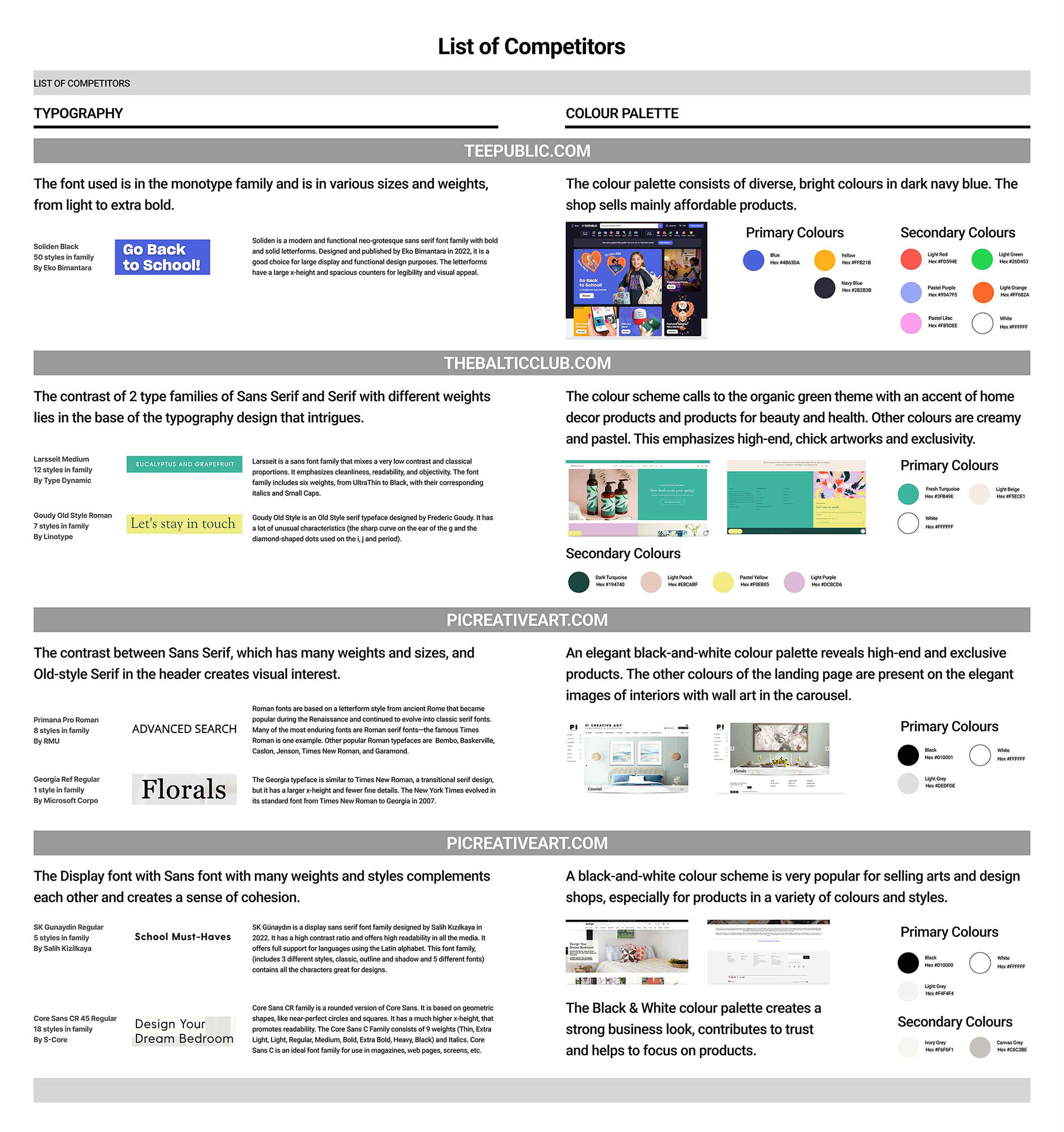
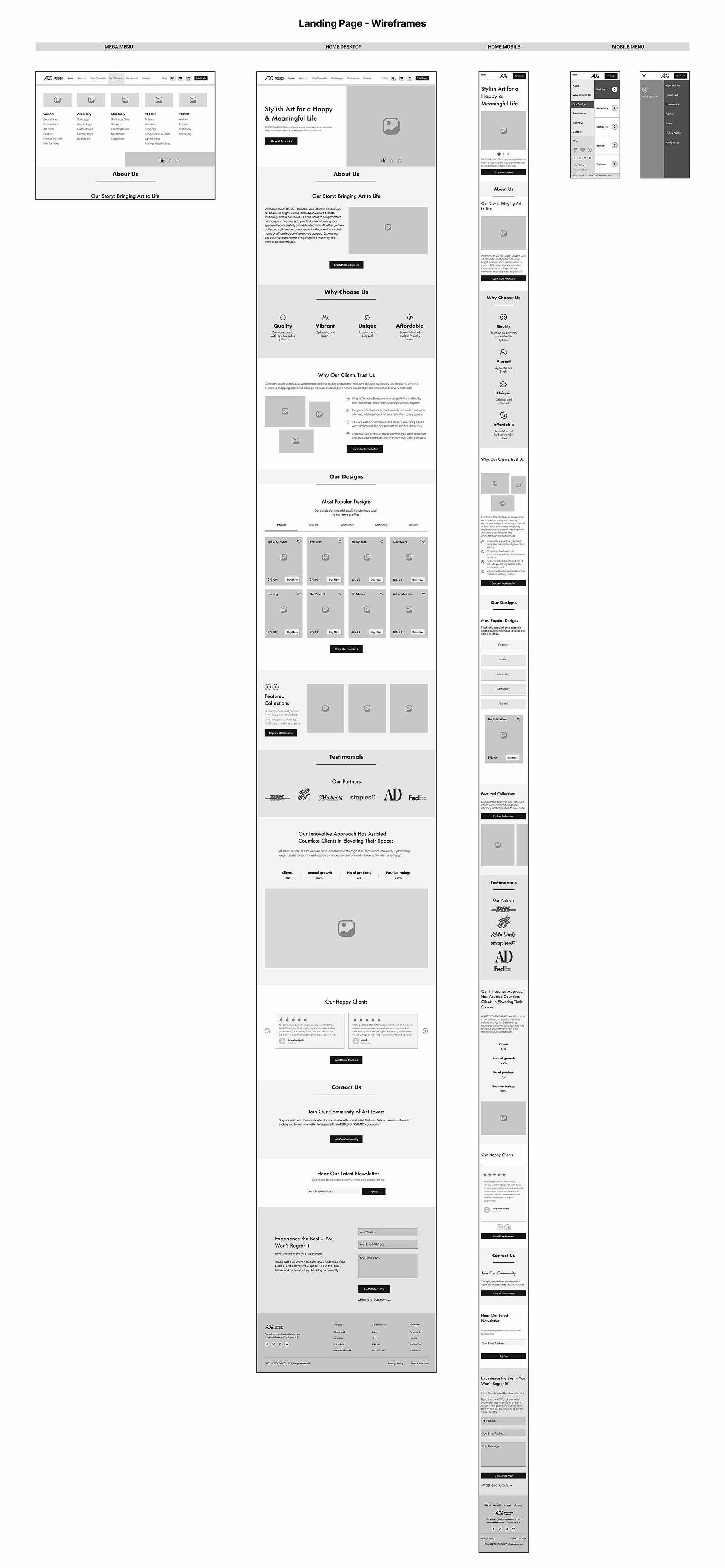
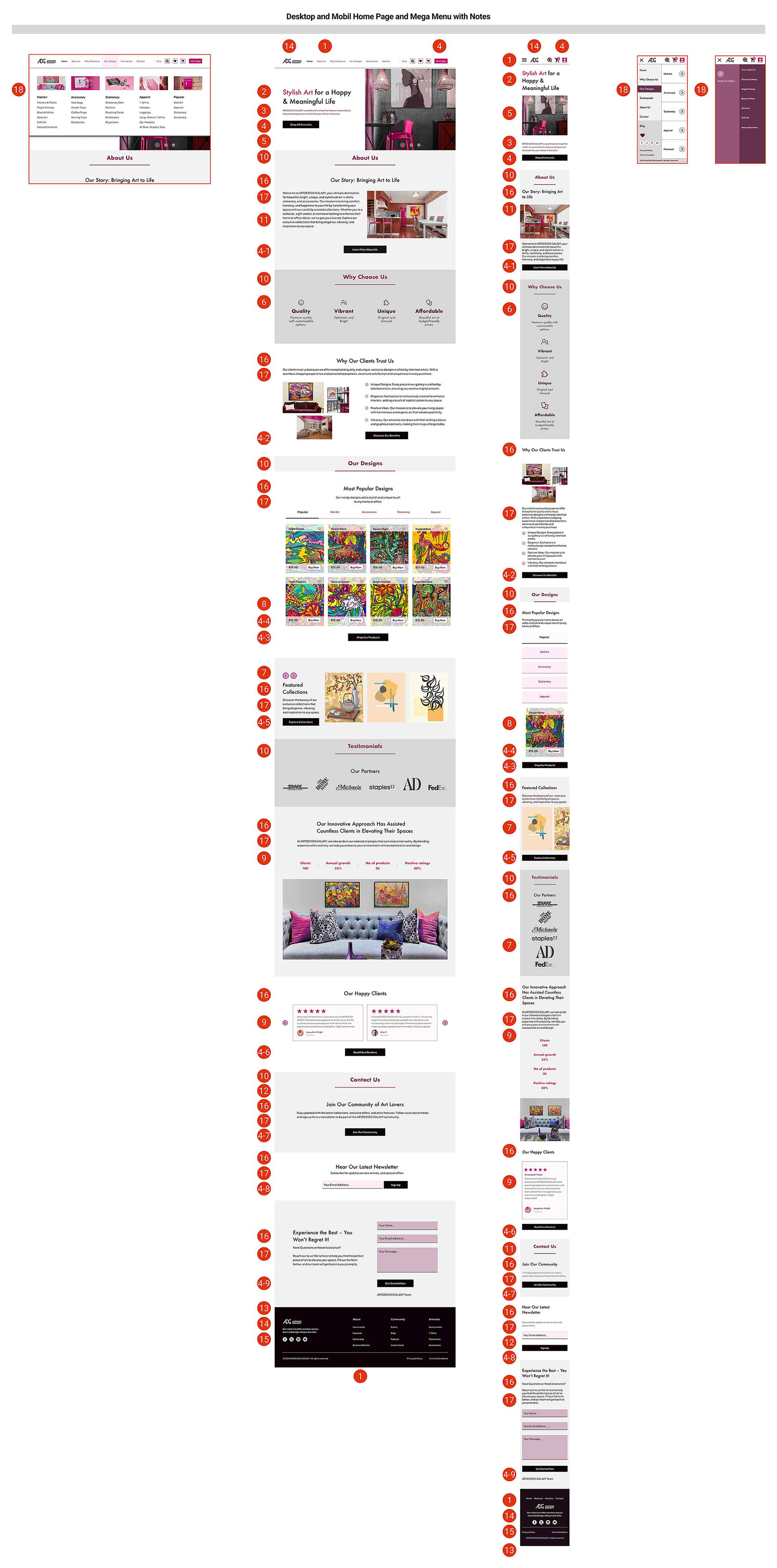

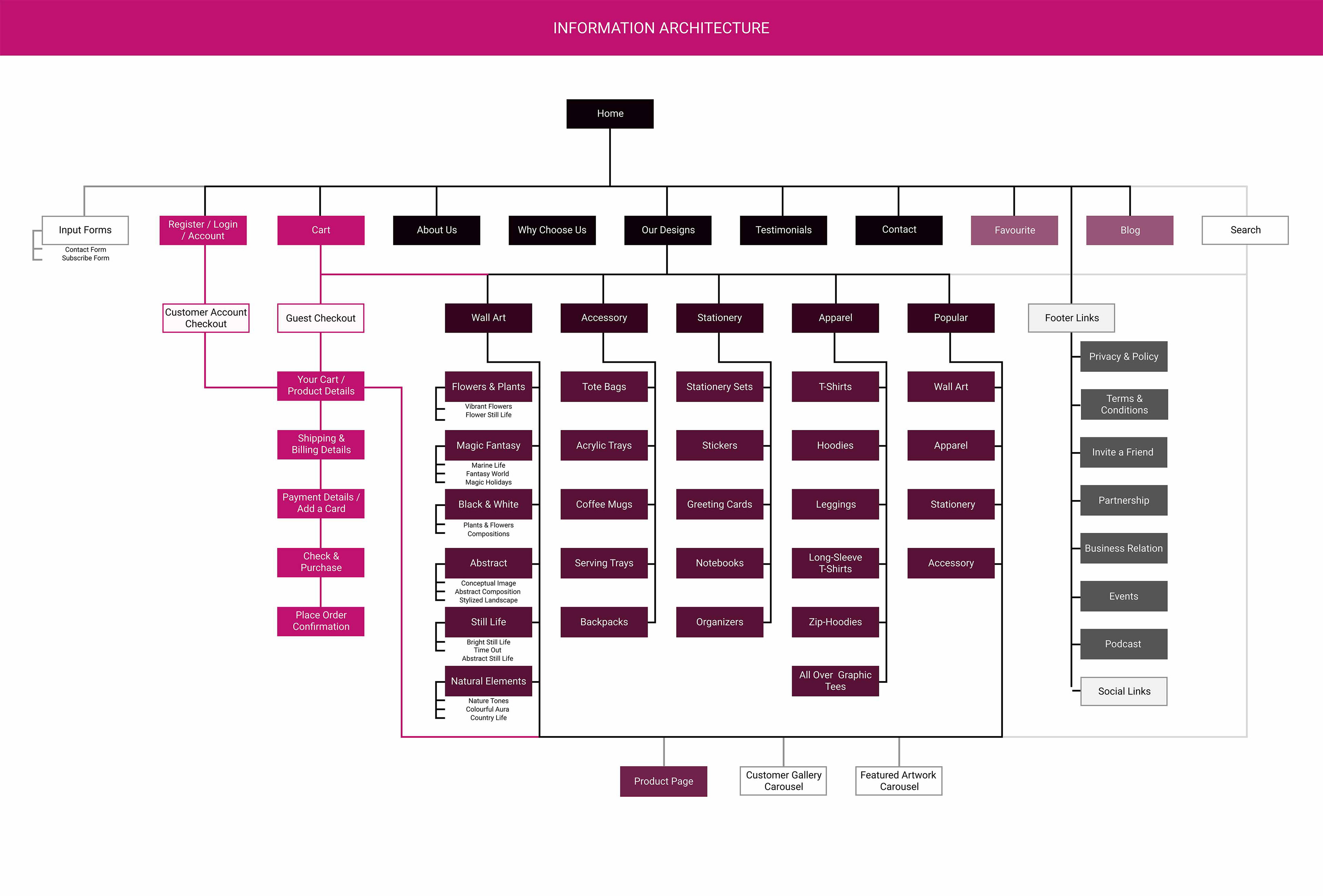

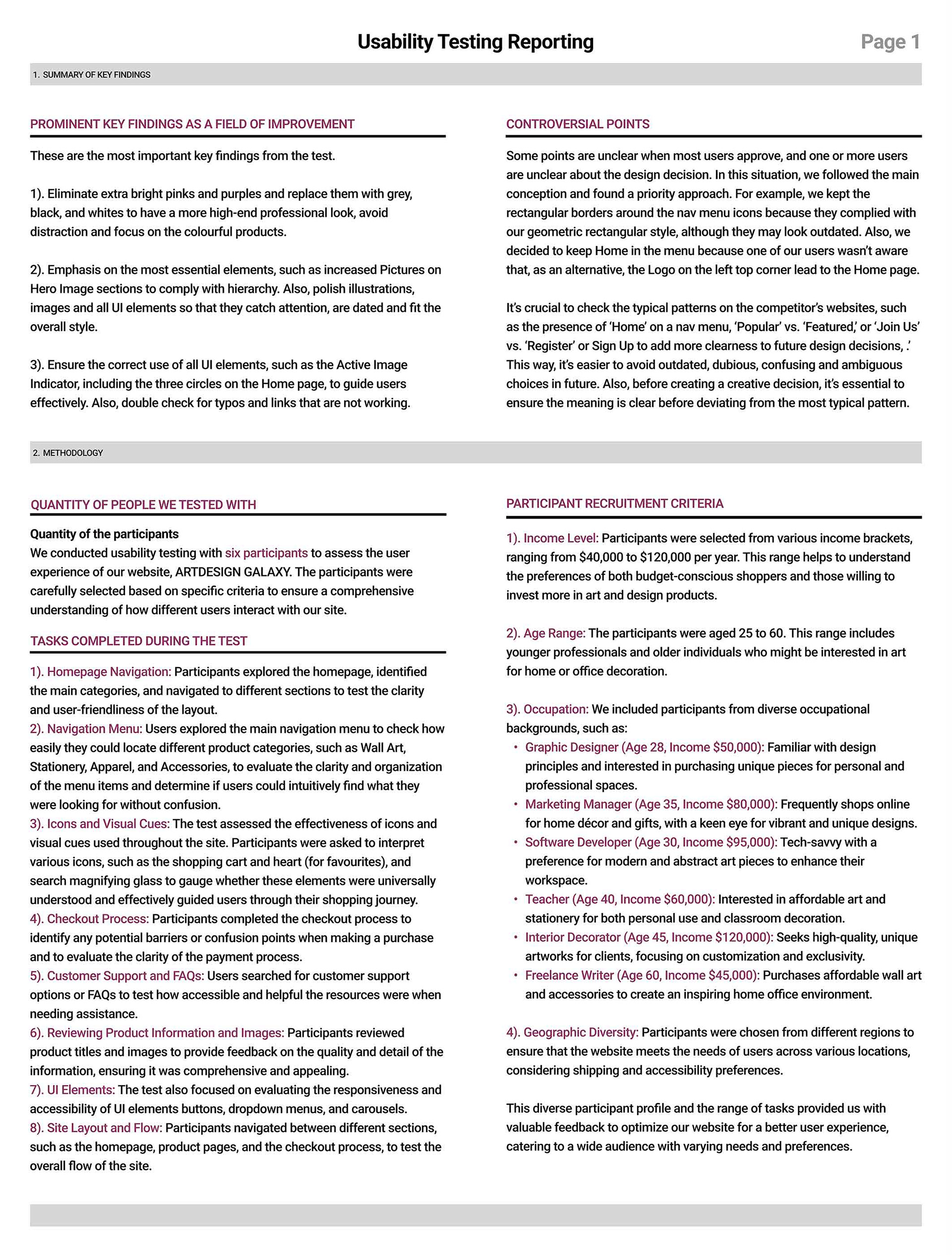
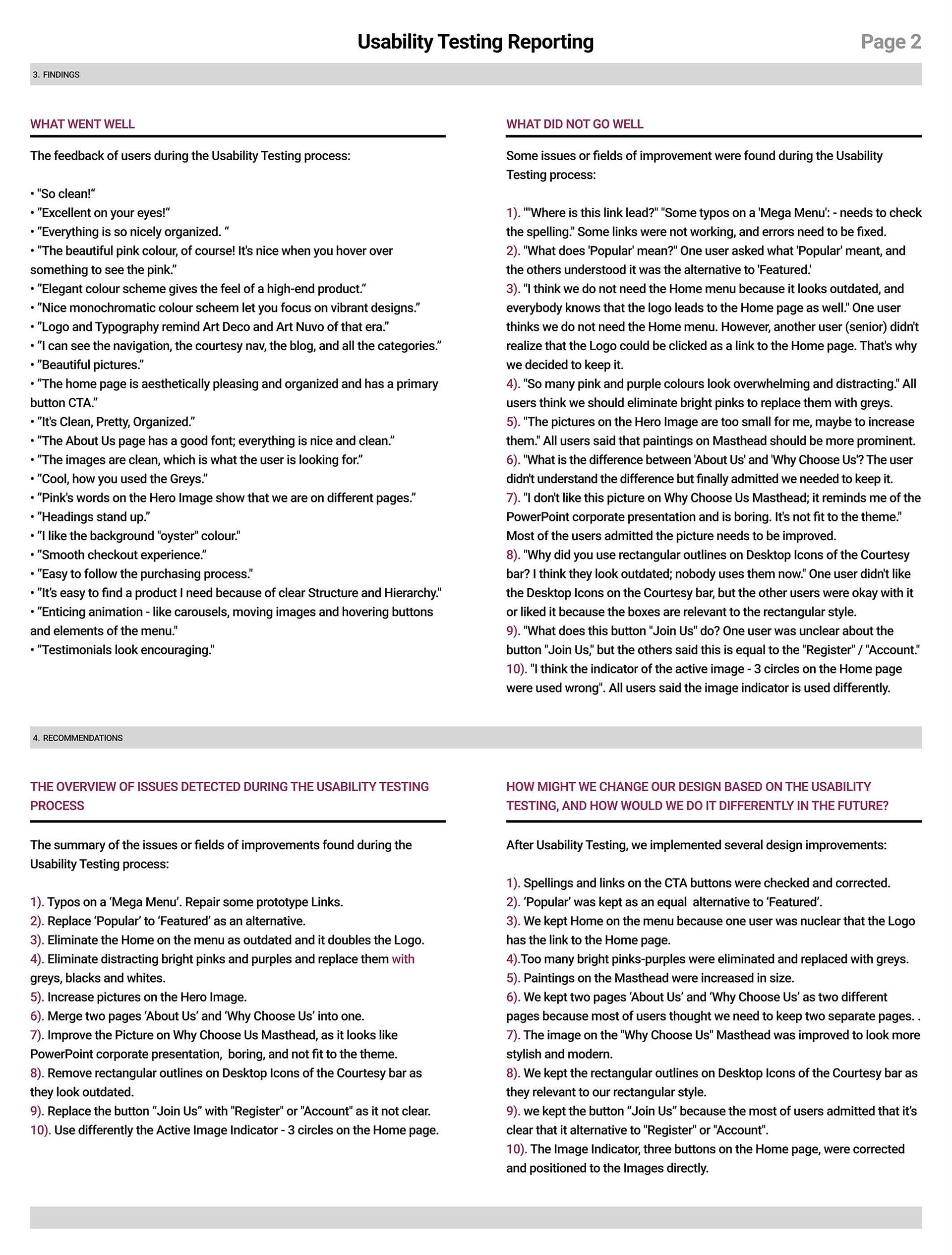


Role and Project Information
Branding, UX/ UI Design. Desktop and Mobile design. Design, prototyping, and animation using Figma.
Role: UX/UI Designer. Tools: Figma, Photoshop, Illustrator. Timeline: 2 months (2024).
Collaboration: As a UX/UI designer, I collaborated with a small team of developers and a product owner. I was responsible for branding and determining the overall design direction of the project while collaborating with the rest of the team on the ideation and implementation.
Introduction
Introduction
The ARTDESIGN GALAXY project was developed to create an engaging and user-friendly online platform for art enthusiasts and home decorators. We aimed to offer a unique collection of high-quality, vibrant, affordable artwork, including wall art, stationery, apparel, and accessories. Recognizing the challenges customers often face when shopping for art online—such as visualizing how pieces will look in their space and navigating a diverse product range—we aimed to enhance the user experience by implementing clear navigation, a clean and modern design, and interactive elements. Through this project, we sought to bridge the gap between online browsing and the tactile experience of art selection, making it easier for customers to find pieces that truly resonate with their personal style and home decor.
Problem and Hypothesis
Problem and Hypothesis for ARTDESIGN GALAXY Project Case Study
Problem: Customers were still determining how the artwork would fit their style and home decor, leading to lower conversion rates and hesitation in purchasing. Additionally, some users needed help to navigate the site effectively, missing key product categories and collections. There also needed to be more engagement and trust, which made users hesitant to make a purchase.
Hypothesis: We hypothesized that showcasing customer photos and a diverse range of product images in real-life settings would increase buyer confidence, helping them better visualize how the pieces would fit into their spaces. Improving the site with a clear and well-structured navigation system would enhance the shopping experience, making it easier for customers to find products that match their tastes and needs.
Additionally, by providing comprehensive information about our company, testimonials, and services, users could better understand how we can help them. Implementing a stylish black, white, and grey colour scheme with a touch of pink, combined with animation and interactive elements, would create an engaging user experience, highlighting our high-end qualitative approach and building trust. These improvements aim to reduce frustration, boost user engagement, and simplify the decision-making process, ultimately increasing conversion rates and reducing returns.
Problem Statement
Problem Statement:
As a new entrant in the art and design market, ARTDESIGN GALAXY needed to establish a solid online presence and effectively engage potential customers. The primary challenge was helping customers visualize how the artwork would fit into their personal spaces and styles, which is crucial for building confidence and driving purchases. Additionally, as a new brand, there needed to be more trust and recognition, which could make users hesitant to purchase.
Furthermore, it was essential to create a user-friendly website that facilitated easy navigation through various product categories, ensuring that users could quickly find products that matched their tastes and preferences. The goal was to address these challenges by implementing a well-structured site, showcasing products in realistic settings, and clearly communicating the brand’s values and product quality to build trust and encourage conversions.
Challenges Faced by Users:
1). Difficulty Visualizing Artwork in Their Spaces: Users needed help to imagine how different pieces of artwork would look in their homes or offices, leading to uncertainty and hesitation in purchasing decisions.
2). Navigational Issues: Some users found it challenging to navigate the website effectively, missing out on key product categories and collections, which led to frustration and a less enjoyable shopping experience.
3). Lack of Trust and Engagement: As a new brand, ARTDESIGN GALAXY faced challenges in establishing trust with potential customers, resulting in skepticism about the quality of products and services.
4). Limited Information About Products: Users sometimes felt that there wasn’t enough detailed information about the products, such as size, materials, and care instructions, making it harder to make informed decisions.
5). Overwhelming Choices: With a wide variety of products available, some users found the number of choices overwhelming, making it challenging to select the right piece of art or design that matched their style.
6). Need for Inspiration: Many users sought inspiration to style their spaces with the artwork but needed more examples or customer photos that could provide ideas and confidence in their choices.
Key Objectives
Our primary objective is to design an intuitive website layout that enhances user experience, making it effortless for customers to find and explore products that suit their style. We aim to boost conversion rates by providing all the necessary information for users to make confident purchase decisions, thereby reducing hesitation and increasing sales. Establishing trust is crucial, so we focus on building credibility through customer reviews, detailed product descriptions, and showcasing the quality of our offerings. Highlighting the diversity and uniqueness of our products is also essential, as it emphasizes their high quality and vibrancy. We strive to increase engagement by incorporating interactive elements and customer-driven content, fostering a strong connection with our brand. Lastly, we aim to facilitate decision-making by offering clear, helpful information, making it easier for customers to choose the perfect piece and reducing return rates.
Purpose of the Project
The purpose of the ARTDESIGN GALAXY project was to create an engaging and seamless online shopping experience for customers seeking unique, high-quality art pieces and design products. We aimed to showcase a diverse range of vibrant, affordable artwork and design products in a way that helps customers easily visualize these items in their own spaces. By improving site navigation, enhancing product visibility with real-life customer photos, and offering detailed information about our offerings, we intended to build trust and confidence in our brand, ultimately increasing user engagement, satisfaction, and conversion rates.
Primary Product Offerings
ARTDESIGN GALAXY specializes in a diverse range of high-quality and affordable art and design products curated to enhance any space. Our primary product offerings include:
1). Wall Art: A selection of exclusive artworks, canvas prints, posters, and art prints in various styles, such as abstract, black & white, and natural elements, designed to elevate the aesthetics of any room.
2). Stationery: Artistically designed notebooks, organizers, stationery sets, and greeting cards that combine functionality with creative flair, perfect for adding a touch of elegance to everyday tasks.
3). Apparel: A range of wearable art, including T-shirts, hoodies, and leggings, featuring unique designs that allow customers to express their style.
4). Accessories: Stylish and practical items such as tote bags, coffee mugs, and other accessories, each adorned with distinctive art that adds a personal touch to daily life.
Each product category is thoughtfully curated to ensure a blend of quality, vibrancy, and uniqueness, catering to a broad audience of art enthusiasts and design lovers.
How we came to our proposed solutions
Usability testing showed users were confused when UI elements, such as the Active Image Indicator, including the three circles on the Home page, didn't function. Also, to guide users effectively, we must emphasize the essential elements, such as increased Pictures on Hero Image sections, to comply with the hierarchy. Moreover, the illustrations, images, and all UI elements must be polished to catch attention, be up to date and fit the overall style.
How our proposed solutions solved the problem
We conducted further usability testing with identical tasks and our new design, which showed a growth in findability compared to the previous round of testing. Users could complete their tasks more smoothly, which gave them a feeling of satisfaction and assurance.
Challenges we faced
Challenges we faced, including design concepts that were ultimately not pursued:
During ideation, we went through a similar colour version of design concepts that ultimately did not completely satisfy user needs. The first design concept we prototyped included more bright pink and purple colours, and this pallet distracted the users from the tasks and the colourful products. Also, they looked less of a high-end and professional. Moreover, the essential design elements needed to be bigger and more polished to fit the overall style.
How the project affected the users and the business
Because users could now focus on the products, feel less distracted and understand the hierarchy of prominent pictures and polished UI elements, they clearly understood how to follow the tasks and completed their goals smoothly with demonstrated satisfaction.
Location
ARTDESIGN GALAXY is an online store accessible from anywhere in the world. While we operate entirely online to offer our diverse selection of art and design pieces, we proudly serve customers across various regions, ensuring that our high-quality, vibrant, and unique products can enhance spaces no matter where you are located. Our digital platform allows us to reach a global audience, delivering exceptional art and design products to your doorstep.
Project Brief
Competitors
Competitors Overview
Most competitors in the market, such as TeePublic, Baltic Club, PI Creative Art, Walker Noble Studio, Society6, Art.com, Redbubble, and Etsy, offer a diverse range of products with efficient delivery processes. They emphasize high-quality offerings with price ranges spanning from affordable to high-end. Customer satisfaction tends to be moderate to high, reflecting a generally positive reception of their products and services.
Key features that set these competitors apart include unique artist designs, various products, print-on-demand services, exclusive handcrafted pieces, limited editions, and curated collections. Additionally, many offer customizable art options, allowing customers to personalize handcrafted, vintage, and unique items from independent sellers, adding a layer of exclusivity and authenticity to their offerings.
Most competitors provide user-friendly website navigation optimized for mobile use, enhancing the overall customer experience. Larger online shops incorporate advanced search functionalities, including filters and facets, to help users find specific products easily. User reviews are prominently displayed, aiding customers in making informed purchasing decisions.
Target Market: The primary audience for these competitors includes art enthusiasts, fashion lovers, collectors, home decorators, and gift buyers, generally aged 30 to 60. The products appeal to those seeking high-quality, unique, and often handcrafted items.
In terms of design, about half of the competitors favour a black-and-white colour scheme, reflecting a minimalist and sophisticated aesthetic. The other half uses a limited palette of bright colours to create a distinctive brand identity while maintaining an appealing visual experience.
Competitors, Their Strengths, Opportunities, and Weaknesses
1. Teepublic
Strengths:
•. Wide variety of unique artist designs.
•. The Print-on-demand model ensures low inventory costs.
•. User-friendly website with robust search and filter options.
Opportunities:
•. Expand into home decor and accessories beyond apparel.
•. Collaborate with more artists to diversify the product range.
Weaknesses:
•. Limited customization options for products.
•. Heavy competition in the print-on-demand market.
2. Baltic Club
Strengths:
•. Focus on high-quality, sustainable materials.
•. Strong brand identity with a minimalist, eco-friendly aesthetic.
Opportunities:
•. Increase online presence through social media and digital marketing.
•. Broaden the product line to include more categories.
Weaknesses:
•. Higher price points may limit market reach.
•. Smaller product variety compared to larger competitors.
3. PI Creative Art
Strengths:
•. Offers exclusive, handcrafted art pieces and limited editions.
•. High-quality products with a strong focus on artistic value.
Opportunities:
•. Expand the digital shopping experience with virtual try-on features.
•. Collaborate with new artists for fresh collections.
Weaknesses:
•. A niche market focus may limit scalability.
•. Higher production costs due to handcrafted nature.
4. Walker Noble Studio
Strengths:
•. Unique, contemporary art pieces with a focus on modern design trends.
•. Online solid branding and customer engagement.
Opportunities:
•. Expand the range of styles to appeal to a broader audience.
•. Develop partnerships with interior designers and home decor influencers.
Weaknesses:
•. Limited to specific styles which may not appeal to all demographics.
•. Dependence on online sales channels without a physical presence.
5. Society6
Strengths:
•. Large marketplace with a diverse range of products from multiple artists.
•. Customizable options are available for many products.
Opportunities:
•. Enhance international shipping options to reach a global audience.
•. Introduce more exclusive artist collections to differentiate from competitors.
Weaknesses:
High competition within the platform may overshadow individual artists.
Quality control can vary due to diverse production sources.
6. Art.com
Strengths:
•. Extensive product variety, including prints, posters, and canvases.
•. Well-established brand with a long history in the art market.
Opportunities:
•. Leverage their strong market presence to introduce new product lines.
•. Enhance digital engagement through augmented reality (AR) features.
Weaknesses:
•. Traditional business models may lack the flexibility of newer competitors.
•. There is less focus on niche or unique artist designs.
7. Redbubble
Strengths:
•. Wide range of products with designs from independent artists.
•. Substantial global reach with a well-established e-commerce platform.
Opportunities:
•. Increase user engagement through personalized recommendations and content.
•. Expand sustainable product lines to attract eco-conscious consumers.
Weaknesses:
•. Quality inconsistency due to various manufacturing partners.
•. A competitive market may dilute brand identity.
8. Etsy
Strengths:
•. Offers a vast range of handcrafted, vintage, and unique items.
•. A strong community of independent sellers with unique products.
Opportunities:
•. Continue to grow international presence and market share.
•. Expand partnerships with local artisans and crafters.
Weaknesses:
•. A highly saturated marketplace makes it difficult for new sellers to stand out.
•. High transaction fees can reduce profit margins for sellers.
Market Analysis
The market for art and design products is diverse, catering to various tastes and preferences. Competitors range from large, well-established companies to smaller niche brands, each with strengths and market positioning. The common thread across the market is the emphasis on unique, high-quality products, often featuring independent artists or limited-edition pieces.
The demand for personalized, meaningful decor and wearable art is growing, particularly among younger consumers who value uniqueness and sustainability. Companies that can effectively combine a robust digital presence with high-quality, diverse product offerings are positioned to capture a significant market share.
Key Trends:
Personalization and Customization: Consumers increasingly seek products that reflect their style and preferences.
Sustainability: Eco-friendly materials and ethical production processes are becoming major selling points.
Digital Engagement: Features such as virtual try-ons and detailed product descriptions enhance the online shopping experience.
Community and Authenticity: Brands that foster community and support independent artists are gaining traction.
Target Audience: The target market for art and design products includes art lovers, fashion enthusiasts, home decorators, and collectors, typically aged 30 to 60. These consumers value quality, uniqueness, and the story behind the products they purchase. The ability to offer products that cater to various tastes and budgets is crucial for reaching this broad audience.
By understanding these strengths, opportunities, and weaknesses, businesses can strategically position themselves to attract and retain customers in a competitive market.
Competitive Landscape Analysis: Identifying Existing Solutions and Opportunities for Differentiation
The art and design market is highly competitive, with various players offering diverse products ranging from affordable prints to high-end original artworks. By analyzing the competitive landscape, ARTDESIGN GALAXY can identify existing solutions provided by competitors and explore opportunities for differentiation.
Existing Solutions in the Market:
1. Wide Product Range: Many competitors, such as Society6, Redbubble, and Art.com, offer various products, including prints, canvases, home decor, and apparel. This extensive selection caters to different customer preferences and price points.
2. Unique Artist Collaborations: Platforms like Teepublic and Etsy focus on showcasing unique designs from independent artists, creating a diverse and original product selection. This approach attracts customers looking for one-of-a-kind pieces that stand out.
3. High-Quality Materials: Competitors like Baltic Club emphasize using high-quality, sustainable materials, appealing to environmentally conscious consumers who prioritize quality and durability.
4. Customizable Products: Many platforms offer customizable options, allowing customers to personalize their purchases to fit their tastes and needs better. This feature is popular among customers who value uniqueness and personalization.
5. Efficient Online Experience: Large competitors such as Art.com and Redbubble provide a seamless online shopping experience with intuitive navigation, robust search functions, and comprehensive filters, enhancing customer satisfaction and ease of use.
7. Community Engagement and Social Proof: Some competitors engage their community by featuring customer photos and reviews prominently, which helps build trust and encourages new customers to make a purchase.
8. Niche Focus: Competitors like PI Creative Art and Walker Noble Studio target specific niches with contemporary and modern art styles, catering to customers looking for pieces that align with current design trends.
Opportunities for Differentiation:
1. Enhanced Virtual Interaction: While some competitors have started integrating features like augmented reality (AR) to visualize art in customers' spaces, ARTDESIGN GALAXY can improve this by providing a more interactive and immersive experience. Developing a sophisticated virtual room tool that lets customers see how various pieces look in different settings could significantly improve user engagement and confidence.
3. Curation and Personalization: By offering curated collections based on customer preferences and past purchases, ARTDESIGN GALAXY can provide a more personalized shopping experience. Utilizing AI to recommend products that match a customer's unique style and home decor can set the brand apart from those with broader, less targeted offerings.
4. Focus on Sustainability and Storytelling: Differentiating by emphasizing sustainability, ethical sourcing, and the stories behind each piece can attract environmentally conscious consumers. Highlighting the journey of the artwork and the artist's background can create a deeper connection with customers.
5. Exclusive Limited Editions and Collaborations: Offering exclusive, limited-edition pieces and collaborating with emerging and renowned artists could help ARTDESIGN GALAXY stand out in a crowded market. Creating a sense of urgency and exclusivity can drive higher conversion rates and foster a loyal customer base.
6. Enhanced Customer Support and Engagement: Providing exceptional customer support with real-time chat options and personalized assistance can differentiate ARTDESIGN GALAXY from competitors. Engaging with customers through social media and email campaigns to showcase new collections and offer tips on home decor can build a stronger community.
7. Educational Content and Inspiration: Creating a blog or content hub with articles, videos, and tutorials on art, design, and home styling can position ARTDESIGN GALAXY as a thought leader. Offering guides on selecting, hanging, and maintaining art can add value and encourage repeat visits to the site.
8. Improved Search and Filter Options: While many competitors offer basic search functionalities, ARTDESIGN GALAXY could enhance this by providing more refined filters, such as searching by room type, colour scheme, or art style, and incorporating user-generated content for a more comprehensive view of each product.
By identifying these opportunities for differentiation, ARTDESIGN GALAXY can strategically position itself in the market, offering unique value propositions that address gaps in the current competitive landscape while aligning with customer needs and preferences.
Project Description
ARTDESIGN GALAXY is an online platform that offers a curated selection of high-quality, vibrant, and unique art pieces, stationery, apparel, and accessories. The website aims to appeal to a broad audience, including art lovers, home decorators, collectors, and gift buyers.
The platform provides an engaging shopping experience with an intuitive layout, clean design, and insightful storytelling about our artists and their creations. ARTDESIGN GALAXY seeks to foster a deeper connection between customers and the artwork, making it a destination for those looking to enhance their spaces with distinctive and inspiring pieces.
Services
At ARTDESIGN GALAXY, we offer a range of thoughtfully curated products to enhance your space and style:
1. Wall Art: Our collection features exclusive art, canvas prints, posters, and art prints that cater to various tastes and home decor styles, allowing you to find the perfect piece to complement your space.
2. Stationery: Discover our unique selection of notebooks, organizers, stationery sets, and greeting cards. Each item is designed to add a touch of creativity and personality to your everyday tasks and correspondence.
3. Apparel: Express your individuality with our range of apparel, including stylish T-shirts, hoodies, and leggings featuring vibrant designs that stand out and make a statement.
4. Accessories: Enhance your daily life with our creative accessories, such as tote bags and coffee mugs, designed to bring art into your everyday routine with function and flair.
Our diverse product offerings aim to bring art into every aspect of your life, making it easy to express your style.
Objectives
•. Showcase Unique Products: Highlight our distinctive collection of wall art, stationery, apparel, and accessories to attract art lovers looking for original and vibrant designs.
•. Simplify Navigation: Design a user-friendly website structure that helps customers easily find and explore different product categories and collections.
•. Boost Customer Confidence: Use high-quality images and detailed descriptions to help customers visualize how our products will look in their spaces, increasing purchase likelihood.
•. Encourage Repeat Purchases: Build loyalty by offering an engaging shopping experience and exceptional customer service, encouraging customers to return for future purchases.
•. Enhance Brand Appeal: Present ARTDESIGN GALAXY as a trusted source for affordable, high-quality art, aiming to become a favourite among those who value unique design and vibrant aesthetics.
•. Enhance User Engagement: Design an intuitive, visually appealing website that encourages visitors to explore and interact with different products.
•. Increase Conversion Rates: Build customer trust with high-quality images, testimonials, and clear descriptions to boost sales.
•. Expand Market Reach: Offer diverse products at various price points to attract both high-end and budget-conscious customers.
•. Improve Customer Satisfaction: Ensure a seamless shopping experience with easy navigation, clear policies, and reliable delivery.
How the Project Stands Out
ARTDESIGN GALAXY distinguishes itself through a curated blend of high-quality, vibrant, and unique artworks that cater to a wide range of tastes and styles. Our focus on exclusivity means offering products that are not only affordable but also stand out due to their originality and artistic value. Unlike many competitors, we provide a well-organized and user-friendly website that enhances the browsing experience, allowing customers to discover new pieces and explore various collections quickly. Additionally, our commitment to showcasing emerging artists and offering a diverse selection ensures our customers can access unique art they won’t find elsewhere.
Project Goals
1. Increase Brand Visibility: Establish ARTDESIGN GALAXY as a go-to destination for unique and high-quality art products by enhancing our online presence and marketing efforts.
2. Boost Sales and Revenue: Drive higher sales by offering a diverse range of art and design products that cater to different tastes and budgets while optimizing the website for conversions.
3. Enhance Customer Experience: Create an intuitive and engaging website that provides a seamless shopping journey from discovery to checkout, ensuring customer satisfaction and fostering loyalty.
4. Support Emerging Artists: Promote and support emerging artists by featuring their work prominently, offering customers unique and exclusive art pieces while giving artists a platform to reach a broader audience.
5. Build Customer Trust and Retention: Foster long-term relationships with customers through exceptional service, transparency, and reliable delivery, aiming to increase repeat purchases and build a loyal customer base.
Business Goals
1. Expand Market Share: Increase ARTDESIGN GALAXY's presence in the online art and design market by attracting new customers and retaining existing ones, positioning the brand as a leader in the industry.
2. Diversify Product Offerings: Continuously expand our product range to include a variety of art styles and categories, such as wall art, stationery, apparel, and accessories, to appeal to a broader audience and meet diverse customer preferences.
3. Optimize Operational Efficiency: Streamline internal processes and logistics, including inventory management and fulfillment, to reduce costs and improve profit margins while maintaining high-quality standards.
4. Enhance Brand Value: Build a strong, recognizable brand identity that resonates with customers through consistent quality, innovative designs, and a commitment to supporting independent artists.
5. Achieve Sustainable Growth: Focus on long-term growth by implementing sustainable business practices, nurturing customer relationships, and investing in marketing and technology to drive sales and enhance customer loyalty.
Project Vision
To establish ARTDESIGN GALAXY as a leading destination for high-quality, unique, affordable art and design products. We aim to create an inspiring online platform that connects customers with diverse and talented artists worldwide, offering a seamless shopping experience that delights, engages, and encourages exploration. We aim to foster a community that values creativity and originality while making exceptional art accessible to everyone, enriching homes and lives with meaningful, beautiful pieces.
Target Audience
ARTDESIGN GALAXY is designed for art enthusiasts, interior decorators, and everyday consumers looking to enhance their living or working spaces with unique and high-quality designs. Our primary audience includes:
1. Home Decorators and Interior Designers: Individuals or professionals seeking distinctive art pieces to personalize and elevate interiors, from modern homes to stylish offices.
2. Art Lovers and Collectors: People passionate about collecting unique art pieces, including limited editions and exclusive designs, who appreciate creativity and craftsmanship.
3. Gift Buyers: Customers looking for unique, thoughtful gifts for friends, family, or colleagues, whether for holidays, birthdays, or special occasions.
4. Creatives and Fashion Enthusiasts: Those who value artistic expression not only in their living spaces but also in their style, looking for apparel and accessories that reflect their love for art.
5. Young Professionals and Millennials (Ages 25-40): A tech-savvy group seeking affordable yet high-quality art and design products that reflect their tastes and lifestyle, often shopping online for convenience and variety.
This diverse audience appreciates vibrant, unique designs and values the ability to choose from a wide range of products that cater to different tastes and budgets.
The Strategy of the UX Project Process
The UX project strategy for ART DESIGN GALAXY focuses on understanding user needs and aligning them with business goals. We began by conducting user research to identify pain points and preferences. Based on insights, we designed intuitive navigation, streamlined the checkout process, and curated content highlighting product quality and uniqueness. Prototyping and usability testing were integral in refining the user experience, ensuring a seamless and engaging journey from product discovery to purchase. Our strategy aims to enhance user satisfaction, increase conversions, and build brand loyalty through a user-centred design approach.
Principles of the Website Design
The website design for ARTDESIGN GALAXY is centred on user experience, prioritizing intuitive navigation, visual appeal, and simplicity. The design ensures responsiveness across devices, focusing on accessibility for all users. Performance optimization is key, providing fast loading times to enhance user engagement. Trust is built through clear policies, customer testimonials, and secure payment options, creating a credible and professional online shopping environment. Overall, these principles aim to deliver a high-quality, engaging, and seamless experience for every visitor.
Type the Product
The products offered by ARTDESIGN GALAXY include wall art, stationery, apparel, and accessories. Each item is designed to combine high-quality craftsmanship with unique, vibrant artistry, catering to diverse tastes and preferences while enhancing home and office spaces.
Strengths and Opportunities:
ARTDESIGN GALAXY stands out for its diverse range of unique and high-quality art products, including wall art, stationery, apparel, and accessories. This variety allows us to appeal to a broad audience with different tastes and budgets. We prioritize vibrant designs and affordability, making our offerings accessible without compromising quality. Our commitment to showcasing original artwork from talented artists provides a distinctive edge, fostering a sense of exclusivity and supporting creativity.
Opportunities for ARTDESIGN GALAXY include expanding our market reach by enhancing our online presence and optimizing our website for a seamless shopping experience. By continuing to innovate with new product lines and collaborating with emerging artists, we can attract new customers and maintain a loyal base. Additionally, focusing on customer engagement through personalized experiences and targeted marketing campaigns presents a chance to deepen relationships and drive sales.
Conducted User Research:
We conducted user research to understand customer preferences, behaviours, and pain points. Through surveys, interviews, and usability tests, we identified key areas for improvement, such as navigation, product discovery, and building trust. These insights informed design decisions to enhance user experience and increase customer satisfaction.
Market Trends and Customer Expectations:
The art and design market is seeing a growing demand for unique, high-quality products that cater to diverse tastes. Customers increasingly expect personalized experiences, quick delivery, and easy website navigation. Additionally, there's a preference for sustainable and ethically produced goods. To meet these expectations, businesses must offer distinctive products, transparent policies, and a seamless online shopping experience.
Project Overview:
The ARTDESIGN GALAXY project aimed to create an engaging and user-friendly online platform to showcase and sell a diverse range of art and design products, including wall art, stationery, apparel, and accessories. Focusing on high-quality, unique, affordable items, the project sought to enhance the customer experience by offering intuitive navigation, vibrant product displays, and informative content. By catering to high-end and budget-conscious customers, the project aimed to broaden market reach, increase conversion rates, and build a loyal customer base. The goal was to establish ARTDESIGN GALAXY as a destination for art lovers and design enthusiasts.
This project encompasses the design and development of the ARTDESIGN GALAXY website, which primarily caters to art enthusiasts. The website scope includes various desktop and mobile screens and features, such as Figma animation, to ensure a responsive design, accessibility and a comprehensive user experience. The main screens include the Home page, About Us, Why Choose Us, Testimonials, Contact, Our Designs with many sub-pages, Account screen, Cart and Checkout process screens.
User Discovery
User Testing:
We conducted comprehensive user testing to identify usability issues and gather insights into customer preferences. Participants were selected based on demographics aligned with our target audience, including art lovers, home decorators, and design enthusiasts. Critical tasks included navigating the site, locating specific products, and completing a purchase. Feedback highlighted the need for more transparent navigation, improved product structure, and enhanced visual appeal. These insights were crucial for refining the user experience, ensuring the website is intuitive, engaging, and effectively meets user needs.
User Testing Interview Questions
The eight questions for user interviews were asked to 4 interviewees for user testing specifically.
1). How do you typically find inspiration for decorating your home or selecting art and design pieces?
2). What features do you consider most important when shopping for art or design products online?
3). Can you describe a recent experience where you purchased art or home decor online? What did you like or dislike about the process?
4). How important is the ability to view product images from different angles or in various settings when deciding on a purchase?
5). What kind of information or details do you look for in product descriptions when buying art or accessories online?
6). How do you feel about the current options for personalizing or customizing art or design products on most websites?
7). What would make you more confident about purchasing art or home decor from a new online retailer?
8). What elements of an online shopping experience make you want to return to a website for future purchases?
4 interview scripts
INTERVIEWEE 1: SARAH JOHNSON
A) Name: Sarah Johnson
B) Occupation: Interior Designer
C) Place of Residence: New York City
D) Neighborhood: Upper East Side
A) Name: Sarah Johnson
B) Occupation: Interior Designer
C) Place of Residence: New York City
D) Neighborhood: Upper East Side
Answers for Interviewee 1, Sarah Johnson:
1). I usually find inspiration through Pinterest and Instagram. I also love browsing interior design magazines and visiting local art galleries for ideas.
2). My essential features are high-quality images, clear descriptions, customer reviews, and an easy-to-navigate website. I also appreciate detailed information about the artist and the story behind the artwork.
3). Recently, I bought a framed print online. I liked that the website had a lot of customer photos showing the print in different settings. However, I found the checkout process confusing, and I wasn’t sure about the return policy.
4). It's very important to me. I want to see how the art looks in different rooms and lighting conditions to be sure it will fit well in my home.
5). I look for details on the dimensions, materials, and care instructions. I also want to know if the colours in the image are accurate or if they might vary slightly in person.
6). I think there could be more options for personalization. While some sites allow you to choose frame styles or sizes, I'd like more customization options, like adjusting colours or adding text.
7). Seeing a lot of positive customer reviews and having a clear, easy-to-find return policy would make me feel more confident. I also appreciate when a retailer visually previews the art in different settings.
8). A user-friendly interface, high-quality product selection, and excellent customer service are key. If I feel the website values my business and provides a seamless experience, I will likely return.
INTERVIEWEE 2: DAVID NGUYEN
A) Name: David Nguyen
B) Occupation: Digital Marketing Specialist
C) Place of Residence: San Francisco
D) Neighborhood: Mission District
A) Name: David Nguyen
B) Occupation: Digital Marketing Specialist
C) Place of Residence: San Francisco
D) Neighborhood: Mission District
Answers for Interviewee 2: David Nguyen
1). I usually get inspiration from design blogs and YouTube channels. I also like visiting local craft fairs and exhibitions to see what’s trending and discover new artists.
2). My most essential features are user reviews, a simple checkout process, and options to filter and sort products by style, size, and price. I also value a mobile-friendly site since I often shop on my phone.
I3). recently purchased a custom poster online. I appreciated the variety of sizes and framing options. However, I found it frustrating that the website didn’t offer enough detailed close-up images of the print.
4). It's crucial. Multiple images and the ability to zoom in give me a better sense of the texture and quality of the piece. I also like to see the art in different room settings to visualize how it might look in my own space.
5). I look for information on the artist, materials used, and the story behind the piece. I also want to know about shipping times and whether the product is handmade or mass-produced.
6). More customization options would be great. It would be nice to have the ability to change colours or add elements to make the art more personal.
7). Seeing detailed product photos, especially in a home setting, helps build my confidence. A straightforward return policy and customer service availability are also important to me.
8). A great selection, easy navigation, and the ability to quickly find what I’m looking for make me want to return. I also appreciate when a site remembers my preferences and past purchases to make future shopping easier.
INTERVIEWEE 3: EMMA ROBERTS
A) Name: Emma Roberts
B) Occupation: Freelance Writer
C) Place of Residence: Chicago
D) Neighborhood: Wicker Park
A) Name: Emma Roberts
B) Occupation: Freelance Writer
C) Place of Residence: Chicago
D) Neighborhood: Wicker Park
Answers for Interviewee 3: Emma Roberts
1). I often find inspiration on Pinterest and Instagram. I follow several art influencers and galleries that showcase new pieces and trends, which helps me stay updated on what’s popular.
2). For me, high-quality images and detailed product descriptions are the most important. I also value a website with a clean, modern design that's easy to navigate, especially on my phone.
3). I recently bought a painting from an online gallery. The experience was mostly good, but the checkout process was confusing because there were too many steps and unnecessary forms to fill out.
4). Very important. Seeing different angles, close-ups, and how the art looks in a room really helps me decide if a piece is right for me. It’s also helpful to see videos or 360-degree views to get a sense of the texture and size.
5). I like to know who the artist is and their background. I’m also interested in the medium, the creative process behind the artwork, and whether it’s an original or a print. Shipping information is also crucial for me.
6). I’d love to see a feature where I can view the artwork in my own space using augmented reality or see more customization options, like choosing different frames or matting.
7). Seeing customer reviews and high-quality images makes me more confident in my purchase. Clear, concise product details and a transparent return policy also help build trust.
8). I look for a site that is visually appealing and easy to navigate. A personalized shopping experience, where I receive recommendations based on my previous views or purchases, is also a big plus.
INTERVIEWEE 4: MICHAEL THOMPSON
A) Name: Michael Thompson
B) Occupation: Art Collector
C) Place of Residence: Seattle
D) Neighborhood: Capitol Hill
A) Name: Michael Thompson
B) Occupation: Art Collector
C) Place of Residence: Seattle
D) Neighborhood: Capitol Hill
Answers for Interviewee 4: Michael Thompson
1). I usually look for new art pieces on dedicated online art stores, social media platforms like Instagram, and, occasionally, local galleries. I appreciate platforms that showcase both emerging and established artists.
2). Clear images and detailed descriptions are essential for me. I also look for user-friendly navigation, customer reviews, and the ability to filter easily and sort products based on categories and styles.
3). I recently bought a sculpture from an online art store. The quality was excellent, but I was disappointed with the lack of detailed product information and the slow shipping process.
4). Very important. Seeing multiple high-quality images and videos helps me understand the artwork’s texture, colour accuracy, and how it might look in different lighting or settings.
I5). want to know about the materials used, the artist's story, the inspiration behind the piece, and any care instructions. I’m also interested in the return policy and shipping details.
6). It would be great to have a feature where I could visualize the art in my home using AR technology. Also, a more interactive way to explore the artist’s portfolio would be interesting.
7). Customer reviews, high-resolution images, and a clear return policy make me more confident when purchasing art online. Knowing other customers' experiences is very reassuring.
8). I prefer websites that are clean, easy to navigate, and provide a personalized experience. Being able to filter my search by different criteria like colour, size, and style is very useful for me.
Summary of User Interviews
The user interviews revealed that customers prioritize a seamless and intuitive shopping experience when purchasing art online. They value high-quality images, detailed product descriptions, and user-friendly navigation to help them make informed decisions. Many users desired more interactive features, such as the ability to visualize art in their own or other customer's space and explore artists' portfolios in depth. Trust-building elements like customer reviews, clear return policies, and comprehensive product details are also critical in influencing purchasing decisions. Overall, users seek a personalized, engaging, and hassle-free shopping experience that caters to their aesthetic preferences and practical needs.
User Interview Insights
1. Visual Appeal and Quality: Users highly value high-quality images and detailed descriptions that accurately represent the art pieces, helping them make confident purchase decisions.
2. Ease of Navigation: A clear, intuitive website layout is essential. Users want to easily find categories and explore different collections without frustration.
3. Personalization and Interactivity: Many users expressed interest in features that allow them to visualize art in their own spaces and access detailed artist information, enhancing the personalization of their shopping experience.
4. Trust and Transparency: Trust-building elements, such as customer reviews, clear return policies, and transparent pricing, significantly impact users' willingness to buy.
5. Diverse Product Range: Users appreciate a variety of styles and price points, catering to both budget-conscious shoppers and those looking for exclusive pieces.
Categories for the Affinity Map
In the context of the ARTDESIGN GALAXY project, the relevant categories for the affinity map include:
1. Visual Appeal: User preferences for design styles, colour schemes, and product aesthetics.
2. Navigation and Usability: Feedback on website layout, product-finding ease, and overall user experience.
3. Product Information: Desires detailed product descriptions, high-quality images, and artist background.
4. Personalization and Interactivity: Interest in features like viewing art in real-life settings and personalized recommendations.
5. Trust and Credibility: Importance of customer reviews, clear return policies, and transparent pricing.
6. Product Range and Variety: User expectations for diverse styles, price points, and product categories.
7. Customer Support and Service: Expectations for responsiveness, helpfulness, and clarity in customer service interactions.
8. Shopping Experience: Overall impressions of the purchasing process, from browsing to checkout, including delivery options and satisfaction.
Analysis of Affinity Map: Comparing Categories and Pain Points
Analyzing the affinity map for the ARTDESIGN GALAXY project allows us to identify how user feedback aligns with existing pain points. Here's a comparison of the key categories from the affinity map with the users' pain points:
1. Visual Appeal vs. Style Uncertainty:
• Category Insight: Users value visually appealing designs and diverse styles. They want the products to align with their personal taste and home decor.
• Pain Point: Many users are uncertain how the artwork will fit their style and space.
• Comparison: To address this, showcasing more diverse product images and using customer photos can help users better visualize the art in their environment, reducing uncertainty.
2 Navigation and Usability vs. Difficulty Finding Products:
• Category Insight: Users highlighted the need for a more intuitive site layout, easier navigation, and quicker access to various product categories.
• Pain Point: Some users struggled to find specific products or collections, causing frustration.
• Comparison: Enhancing the site’s navigation structure and making popular categories easily accessible can alleviate these pain points and improve the overall user experience.
3. Product Information vs. Lack of Detailed Descriptions:
• Category Insight: Users want comprehensive details, such as high-quality images, accurate descriptions, and information about the artists and materials.
• Pain Point: Users were sometimes hesitant to purchase due to a lack of detailed product information.
• Comparison: Providing thorough descriptions and multiple high-resolution images per product can reduce hesitation and build trust, addressing the need for more information.
4. Personalization and Interactivity vs. Lack of Engagement:
• Category Insight: There is interest in features that allow users to see how products would look in real settings or receive personalized recommendations.
• Pain Point: Users felt a lack of engagement and interactivity, making the shopping experience less immersive.
• Comparison: Implementing interactive features, such as "View in Your Room" tools or personalization options, can enhance engagement and make the experience more enjoyable.
5. Trust and Credibility vs. Hesitation to Purchase:
• Category Insight: Users needed visible customer reviews, clear return policies, and transparent pricing to build trust.
• Pain Point: Some users hesitate to purchase due to doubts about the product’s quality or credibility.
• Comparison: Promising customer reviews and ensuring clear communication about return policies can enhance credibility and reduce hesitation.
6. Product Range and Variety vs. Limited Product Awareness:
• Category Insight: Users appreciate various product styles and price points to cater to different tastes and budgets.
• Pain Point: Some users were unaware of the full range of products available, limiting their choices.
• Comparison: Promoting a diverse selection of products and highlighting new or unique items can increase awareness and meet users’ needs for variety.
7. Customer Support and Service vs. Frustration with Support:
• Category Insight: Users expect quick, responsive, transparent customer support to address issues or questions.
• Pain Point: Frustrations arose when users had difficulties contacting customer service or when responses were slow or unhelpful.
• Comparison: Improving the responsiveness and quality of customer support can directly address these pain points and improve overall satisfaction.
8. Shopping Experience vs. Complicated Checkout Process:
• Category Insight: Users want a seamless shopping experience from browsing to checkout, including smooth delivery options.
• Pain Point: Some users found the checkout process cumbersome or confusing.
• Comparison: Simplifying the checkout process and providing clear instructions can reduce frustration and enhance the shopping experience.
By aligning the insights from the affinity map with the identified pain points, ARTDESIGN GALAXY can prioritize changes that directly address user frustrations, enhance the user experience, and ultimately improve engagement and conversion rates.
User Personas
5 User Personas
User Persona 1: Sarah Johnson
User Details:
• Age: 34
• Occupation: Marketing Manager
• Location: Los Angeles, CA
• Tech Proficiency: High
Goals:
• To find high-quality, unique artwork that complements her modern home decor.
• To purchase art that reflects her taste and is different from what her friends have.
• To enjoy a seamless shopping experience online, from browsing to checkout.
Behavior:
• Frequently browses art and design websites for inspiration.
• Prefers websites with a clean, modern design and intuitive navigation.
• Often shares her findings on social media and seeks peer validation before purchasing.
Needs:
• Detailed product descriptions and high-resolution images to better understand the quality and style of the artwork.
• Easy-to-use filtering options to quickly find pieces that match her preferences.
• Assurance of quality and the ability to see how the artwork would look in her space.
Pain Points:
• Difficulty visualizing how the artwork will fit into her home decor.
• Overwhelmed by too many options without adequate categorization.
• Concerns about the quality of products when shopping online.
Challenges:
• Making sure the artwork complements her existing decor and fits within her budget.
• Finding time to search through multiple websites to compare options and prices.
• Overcoming hesitation due to fear of committing to a piece that may not look as expected in real life.
Expectations:
• A curated selection of high-quality, unique artwork that aligns with her tastes.
• User-friendly navigation and search features.
• Reliable customer service and a clear return policy for peace of mind.
Motivations:
• Desire to create a stylish, personalized living space that impresses guests.
• Satisfaction from finding and purchasing unique, beautiful art.
• The convenience of a seamless online shopping experience with fast delivery.
User Persona 2: David Nguyen
User Details:
• Age: 45
• Occupation: Architect
vLocation: Seattle, WA
• Tech Proficiency: High
Goals:
• To source high-quality, contemporary art pieces for client projects.
• To find visually impactful artworks and complement the aesthetic of the spaces he designs.
• To collaborate with artists or purchase exclusive pieces that add value to his projects.
Behavior:
• Spends time researching artists and trends in contemporary art.
• Prefers websites that showcase a wide range of styles and mediums.
• Values exclusivity and originality in the pieces he chooses for his projects.
Needs:
• Access to unique and exclusive pieces that cannot be found in mainstream stores.
• Detailed information on the artwork’s dimensions, materials, and artist background.
• Reliable shipping and handling services to ensure the art arrives in perfect condition.
Pain Points:
• Frustration with limited options or lack of unique art pieces on most websites.
• Difficulty in finding exclusive art that aligns with his client's vision and project requirements.
• Concerns about the quality and authenticity of artwork purchased online.
Challenges:
• Balancing the need for unique, high-quality pieces with project budgets.
• Ensuring timely delivery of art pieces to meet project deadlines.
• Managing client expectations regarding the selection and quality of artwork.
Expectations:
• A diverse selection of high-quality, exclusive art pieces.
• A seamless purchase and delivery process with options for expedited shipping.
• Robust customer service to handle any issues or special requests.
Motivations:
• Passion for incorporating unique and impactful art into his design projects.
• Desire to impress clients with exceptional and exclusive art choices.
• Satisfaction from successfully finding and integrating art that enhances his projects.
User Persona 3: Emma Roberts
User Details:
• Age: 27
• Occupation: Freelance Graphic Designer
• Location: New York, NY
• Tech Proficiency: High
Goals:
• To find affordable yet high-quality art prints that inspire creativity in her workspace.
• To purchase pieces that reflect her eclectic style and are budget-friendly.
• To discover emerging artists and unique designs that align with her interests.
Behavior:
• Frequently shops online for affordable art prints and design inspiration.
• Engages with artist communities and often follows emerging talents on social media.
• Prefers websites that offer a mix of affordability and unique designs.
Needs:
• Affordable options without compromising on quality or originality.
• Easy access to new and emerging artists' works.
• Clear, concise information on pricing, shipping, and return policies.
Pain Points:
• Struggles to find affordable art that is also unique and well-crafted.
• Limited options for discovering new artists outside mainstream platforms.
• Concerns about the shipping costs and quality of prints ordered online.
Challenges:
• Balancing a tight budget while wanting to invest in art that inspires and motivates her.
• Navigating a sea of mass-produced art to find unique and affordable pieces.
• Ensuring that the prints she orders online meet her quality expectations.
Expectations:
• A curated selection of affordable art prints that do not sacrifice quality or uniqueness.
• Regular updates on new artists and limited edition releases.
• Transparent pricing and shipping information to avoid unexpected costs.
Motivations:
• Passion for supporting emerging artists and adding unique art to her collection.
• Enjoyment of a beautifully curated space that fuels her creativity.
• The satisfaction of finding a great deal on art that she loves.
User Persona 4: Michael Thompson
User Details:
• Age: 52
• Occupation: Real Estate Agent
• Location: Chicago, IL
• Tech Proficiency: Moderate
Goals:
• To purchase art that enhances the visual appeal of properties he’s selling.
• To find versatile pieces that can suit a variety of interior styles.
• To create a welcoming atmosphere in homes to attract potential buyers.
Behavior:
• Shops online sporadically, mostly when staging properties for sale.
• Prefers websites with straightforward navigation and clear product categories.
• Values functionality and aesthetics equally when choosing art.
Needs:
• Versatile art pieces that can easily blend with different home decor.
• Options for bulk purchasing or discounts when buying multiple pieces.
• Reliable customer service and flexible return policies.
Pain Points:
• Frustration with unclear return policies or complicated return processes.
• Difficulty finding art that is both appealing and versatile for various properties.
• Limited access to affordable yet stylish artwork suitable for staging homes.
Challenges:
• Managing costs while needing to purchase art for multiple properties frequently.
• Ensuring the art chosen appeals to a wide range of potential buyers.
• Navigating online platforms to find good deals and quality pieces without spending too much time.
Expectations:
• A good selection of versatile and stylish artwork at competitive prices.
• Easy and efficient browsing and checkout experience.• z
• Reliable customer service and a hassle-free return process.
Motivations:
• Desire to enhance the visual appeal of properties to facilitate faster sales.
• Enjoyment of creating aesthetically pleasing environments that attract potential buyers.
• The satisfaction of finding quality art that fits within his budget.
User Persona 5: Olivia Martinez
User Details:
• Age: 38
• Occupation: Boutique Owner
• Location: Miami, FL
• Tech Proficiency: Moderate
Goals:
• To find unique art pieces that can be sold in her boutique.
• To curate a collection that appeals to her store’s clientele, who are looking for distinctive home decor items.
• To support local and emerging artists by showcasing their work.
Behavior:
• Regularly browses online and visits art fairs to find unique products for her store.
• Prefers websites that offer wholesale pricing or bulk order options.
• Looks for art that aligns with her boutique’s brand of uniqueness and quality.
Needs:
• Access to unique and limited-edition pieces that aren’t widely available.
• Options for bulk purchases with potential discounts or wholesale pricing.
• Clear communication about stock availability and lead times for larger orders.
Pain Points:
• She has difficulty finding unique, high-quality art that fits her boutique’s aesthetic.
• Frustration with websites that do not offer wholesale options or bulk discounts.
• Concerns about the consistency of product quality when ordering multiple pieces.
Challenges:
• Balancing her desire for unique items with the need to manage costs and inventory effectively.
• Ensuring that the art she purchases resonates with her customers and enhances her store’s appeal.
• Navigating online platforms to find reliable suppliers and unique products.
Expectations:
• A curated selection of unique, high-quality art pieces suitable for her boutique.
• Easy access to bulk order options and clear communication about pricing and lead times.
• Consistent product quality and reliable customer service.
Motivations:
• Passion for supporting artists and curating a distinctive collection for her customers.
• Enjoyment of creating a unique shopping experience in her boutique.
• Satisfaction from finding
Pain Points
Pain Points for the ARTDESIGN GALAXY project based on the user personas:
1. Difficulty Visualizing Artwork in Their Space: Users struggle to imagine how different art pieces will look in their homes or workspaces, leading to hesitation in purchasing.
2. Overwhelming Choices: The large variety of artwork can be overwhelming, making it difficult for users to narrow their choices and find pieces that fit their style and needs.
3. Concerns About Quality and Authenticity: Users worry about the quality and authenticity of the artwork when shopping online, especially if they are unfamiliar with the artists or the platform.
4. Limited Access to Unique and Exclusive Art: Some users find it challenging to discover unique or exclusive pieces that are not widely available, which reduces the perceived value of the artwork.
5. Unclear Return and Shipping Policies: Ambiguities around return and shipping policies cause frustration, especially if users are unsatisfied with their purchase or if the artwork does not meet their expectations upon arrival.
6. Inadequate Information on Artwork: Lack of detailed descriptions, dimensions, and context about the artwork and the artists makes it hard for users to make informed decisions.
7. High Prices Without Assurance: Users may feel that prices are high relative to the perceived quality or uniqueness of the art, mainly when there are no assurances like customer reviews, return options, or detailed product insights.
8. Navigation Challenges: Some users need help navigating the website, particularly when trying to filter or search for specific styles or types of artwork, leading to a frustrating user experience.
9. Concerns About Shipping Costs and Timing: Users are often concerned about high shipping costs and potential delays, which can deter them from completing a purchase.
10. Lack of Personalization: Users feel that the website needs to sufficiently cater to their tastes and preferences, which affects their engagement and satisfaction with the shopping experience.
Problem Statement:
ARTDESIGN GALAXY aims to provide a seamless online shopping experience for art enthusiasts and home decorators. However, many potential customers are hesitant to make purchases due to difficulties visualizing how an artwork will fit into their spaces, an overwhelming variety of choices, and concerns about the quality and authenticity of products. Additionally, users experience challenges with site navigation, unclear return and shipping policies, and a need for personalized recommendations. These issues result in lower conversion rates, reduced customer satisfaction, and missed opportunities for engagement and repeat business. Our goal is to address these challenges by enhancing the user experience, improving trust and clarity, and providing tools that help customers make confident, informed decisions.
Solutions:
1. Enhanced Visual Tools: Develop interactive features such as interactive animation elements, augmented reality (AR) or visualization tools that allow customers to see how art pieces will look in their own spaces, increasing confidence in their purchasing decisions.
2. Streamlined Navigation and Categorization: Improve website navigation with intuitive menus and filters that help users quickly find products that match their tastes and needs, reducing the feeling of overwhelm and enhancing user satisfaction.Heart Icon as a tag for a Favourite page to categorize products.
3. Clear Product Descriptions and Quality Assurance: Provide detailed product descriptions, high-quality images, and customer reviews to assure customers of the quality and authenticity of each piece, fostering trust and credibility.
4. Personalized Recommendations: Implement a recommendation system based on user behaviour and preferences to suggest relevant products, improving user engagement and increasing the likelihood of conversion.
5. Transparent Policies and Support: Offer clear, easily accessible information about shipping, returns, and customer support, helping to alleviate customer concerns and improve overall satisfaction.
6. Engaging Content and Community Building: Utilize customer photos, testimonials, and artist stories to create a sense of community and connection, encouraging customer engagement and repeat visits.
7. Responsive and Mobile-Friendly Design: Ensure the website is fully optimized for mobile devices, providing a seamless shopping experience across all platforms.
Moodboard:
The ARTDESIGN GALAXY mood board blends modern sophistication and artistic vibrancy. It features a monochrome palette of black, white, and grey with subtle pink accents to add a pop of colour and draw attention to critical elements. The visual style includes clean, minimalist layouts, bold typography, and a mix of textured and flat design elements to create a sense of depth and visual interest. Imagery focuses on high-quality art pieces in various real-life settings, customer testimonials, and artist profiles to evoke trust and a personal connection with the brand. Overall, the mood board reflects a high-end, contemporary aesthetic that appeals to diverse art lovers and home decorators.
Information Architecture & Navigation
Card Sorting
Card sorting was an essential part of the ARTDESIGN GALAXY project, helping us design a user-friendly and intuitive website structure. By engaging participants in organizing and categorizing content, we gained valuable insights into how users naturally expect to navigate through our product offerings, including Wall Art, Stationery, Apparel, and Accessories. This exercise ensured that our website’s navigation aligns with user expectations, making it easier for visitors to find and explore our diverse range of products.
Grouping Cards into Categories
For the ARTDESIGN GALAXY website card sorting exercise, participants used the following cards to categorize and structure the content and features:
1. Home
• Overview of ARTDESIGN GALAXY; • Featured Collections; • New Arrivals; • Popular Products
2. Wall Art
• Exclusive Art; • Canvas Prints; • Art Prints; • Posters
3. Apparel
• T-Shirts; • Hoodies; • Leggings; • Accessories
4. Stationery
• Notebooks; • Organizers; • Stationary Sets; • Greeting Cards
5. Accessories
• Tote Bags; • Coffee Mugs; • Phone Cases; • Home Decor
6. About Us
• Our Story; • Meet the Team; • Our Standards; • Press & Media
7. Customer Reviews
• Testimonials; • Partner Reviews; • Customer Feedback
8. Shopping Cart
• Your Items; • Marked as Favourite; • Purchased Before; • Related Products
7. Checkout
• Order Summary; • Payment Options; • Shipping Details; • Review Order
8. Contact Us
• Customer Support; • FAQs; • Store Locations; • Contact Form
9. Blog
• Art & Design Tips; • Customer Stories; • Artist Interviews; • Industry News
10. FAQs
• Ordering Process; • Shipping Information; • Returns & Exchanges; • Product Care
Participants used these cards to create logical groupings that made navigating the website intuitive and aligned with user expectations.
Information Architecture for ARTDESIGN GALAXY
The Information Architecture (IA) of the ARTDESIGN GALAXY website is designed to provide a seamless and intuitive user experience, ensuring that visitors can easily find and navigate through our diverse product offerings. The structure is organized into clear categories and subcategories, reflecting the natural flow of user interactions.
Top-Level Navigation
1. Home
• Introduction to ARTDESIGN GALAXY
• Featured Collections
• Popular Products
2. Our Designs
• Wall Art
• Flowers & Plants
• Magic Fantasy
• Black & White
• Abstract
• Still Life
• Natural Elements
• Apparel
• T-Shirts
• Hoodies
• Leggings
• Stationery
• Notebooks
• Organizers
• Stationary Sets
• Greeting Cards
• Accessories
• Tote Bags
• Coffee Mugs
3. About Us
• Our Story
• The Team
• Mission & Vision
4. Why Choose Us
• More About Us
• Our Features and Benefits
4. Testimonials
• Customer Reviews
• Partner Reviews
5. Cart
• Your Items
• Recommended Based on Your Shopping Trends
• Browsing History
• Order Summary
6. Contact
• Contact Form
• Address & Location
• Social Media Links
Sub-Level Navigation
• Wall Art: Each subcategory under Wall Art (e.g., Flowers & Plants, Magic Fantasy) is further divided into different styles and themes to guide users to the exact type of artwork they seek.
• Apparel: Includes subcategories for each type of clothing, offering various design options and sizes.
• Stationery: Divided into functional categories to help users find the right organizational tools or decorative paper products.
• Accessories: Allows easy navigation through different accessory types, such as bags and mugs, with options for personalization or unique designs.
Footer
• Site Links: Quick access to Privacy Policy, Terms of Service, and FAQ.
• Customer Service: Contact information, Return Policy, and Shipping Information.
• Social Media: Links to ARTDESIGN GALAXY’s social media profiles for further engagement.
This Information Architecture ensures that all content and products are logically categorized, allowing users to find what they need quickly, enhancing overall user satisfaction and encouraging repeat visits.
User Flow for ARTDESIGN GALAXY Website
1. USER FLOW: Home Page. The user enters the site and lands on the Home page
• Scroll to explore different sections (About Us, Why Choose Us, Out Designs grid, Featured Collection carousel, Testimonials, Input Forms)
• Explore Our Designs grid with different product categories (Wall Art, Stationery, Apparel, Accessories, Popular Items)
• Click on the right and left arrows to list the ‘Featured Collections’ carousel and ‘Our Happy Clients’ section of the Reviews
• Possibly Sign Up for Newsletters and write a message in the Input Form below
• Click the CTA buttons and navigate to ‘Our Designs,’ ‘About Us,’ ‘Why Choose Us,’ ‘Testimonials,’ and ‘Contact’ pages to explore more
2. USER FLOW: Our Designs’ page. Users navigate the ‘Our Designs’ page to explore all product categories
• Scroll to explore different product categories (Wall Art, Stationery, Apparel, Accessories, Popular Items)
• Scroll down and Click on the right and left arrows to list the ‘Customer Gallery’ carousel
• Scroll down to read ‘More Benefits’
• Click on the right and left arrows to list the ‘Featured Collection’ carousel
• Choose one Category, ex. ‘Wall Art’ and click CTA: ‘Brows Wall Art’ to navigate to the Wall Art page to explore more
3. USER FLOW: Navigation to Product Categories. The user clicks on a product category (e.g., Wall Art).
• Navigate to the Wall Art sub-page category to explore all types of Wall Art
• Explore Popular Wall Art and all collections of Wall Art by categories
• Click ‘Like’ (Heart Icon) to add Pictures to Favourite
• Click on the right and left arrows to view the ‘Customer Gallery’ and ‘Featured Collections’ carousels
• Choose one of the sub-categories of Wall Art (ex., Flowers & Plants) and click the CTA button: ‘Explore Flowers & Plants’ to navigate the page
4. USER FLOW: Navigation to Product sub-Categories. The user clicks on the product sub-category
• Scroll to explore the sub-category pages of Flowers & Plants page: ‘Vibrant Flowers’ and ‘Flower Still Life.’
• Click ‘Load More’ and ‘Load Less’ buttons to explore the sub-categories of the Flowers & Plants page
• Click on the right and left arrows to view ‘Customer Gallery’ and Click ‘Like’ (Heart Icon) to add Pictures to your Favourite
• ‘Featured Collections’ carousels, ‘View Wall Art Collections’ and ‘Explore Popular Wall Art’ CTA buttons
• Choose one of the sub-categories of Wall Art (ex., Flowers & Plants) and click the CTA button: ‘Explore Flowers & Plants’ to navigate the page
5. USER FLOW: PRODUCT DETAIL PAGE. The user selects a specific product to view more details.
• Click on a specific Product and open the Product Detail Page to view more details
• View product images, descriptions, artist information, and price
• Choose product options (e.g., size, finish)
• Choose product options (e.g., size, finish)
• Click CTAs: “Add to Cart,” ‘View Customer Gallery,’ ‘See Related Products.’ Click the ‘Buy Now’ CTA button and add the product to the Cart
6. USER FLOW: selection and adding Products to cart. The user clicks on the product sub-category
• Add the desired product to the cart and adjust quantities or options directly in the cart (‘Remove’ button).
• Continue shopping by clicking the ‘Back’ button or proceed to checkout.
• Review sections below: ‘Best Recommended ‘grid, ‘Browsing History’ and ‘Your Personalized Pick’
• Scroll down to view sections: Apply Discount Code, Estimated Delivery, Secure Checkout, Customer Support
• Continue Shopping by clicking the ‘Proceed to Checkout’ button
7. USER FLOW: Checkout & Order Confirmation Page. Users go through the checkout process.
• Enter Shipping Details and select a shipping method by filling in Input Forms
• Enter Billing Details - possibly coping shipping information by checking a checkmark
• Enter the Payment Method by filling in your card information. Click the ‘Add a Card’ button
• Review the order summary before finalizing the purchase. Click the ‘Checkout’ button
• View order details and confirmation number. Option to print or save the order summary. Receive an estimated delivery date
8. USER FLOW: Post-Purchase Engagement. The user navigates to different sections for additional engagement.
• Explore the ‘About Us’ page to learn more about the company’s mission, team, and sustainability efforts
• Read the ‘Testimonials’ page to see reviews from other customers and partners
• Visit the ‘Why Choose Us’ page to read more about our features and benefits
• Navigate to the ‘Contact Us’ page. Fill out a contact form or access the FAQ for quick answers, utilize customer support chat or phone for immediate assistance
• Explore the ‘Blog’ page and the ‘Favourites’ (Heart Icon) page. Use the Search function on top of each page
9. USER FLOW: Account Management (if applicable). User logs into their account to manage details.
• Register / Login to Account to manage details
• View order history, track current orders, and manage payment methods
• Update account information (email, address, password)
• Access saved items or wish lists for future purchases
• On the ‘Contact Us’ page, utilize customer support chat or phone for immediate assistance
Consistent navigation elements across all screens
In the ARTDESIGN GALAXY project, consistent navigation elements were meticulously designed to provide users with a smooth and intuitive browsing experience across all pages. This consistency ensures that users can easily access critical sections, such as product categories (Wall Art, Stationery, Apparel, and Accessories), shopping cart, and account information, without confusion or unnecessary clicks. The navigation bar is always at the top of each page, with clearly labelled tabs and a responsive design that adapts to different devices, ensuring a cohesive experience whether on desktop, tablet, or mobile. When we click the Search Icon, the interactive Search bar popup appears on desktop and tablet versions. This approach enhances usability and helps build trust and familiarity, encouraging users to explore more of the site more confidently.
User Testing Process
The User Testing Process for the ARTDESIGN GALAXY project involved multiple stages to ensure the website met user needs and expectations. Initially, we conducted prototype testing, using paper prototypes to gather quick feedback on layout and navigation. This was followed by usability testing with a select group of participants who matched our target audience. During these sessions, users were asked to complete critical tasks, such as finding specific products, navigating between categories, and adding items to the cart. We observed their interactions, noting any pain points or confusion. Feedback was collected through post-test interviews, where participants shared their thoughts on the overall experience, design, and functionality. This iterative process allowed us to refine the design and improve the user experience before the final launch.
POP testing
POP (Prototype on Paper) testing is a usability testing method where a paper prototype of the website or app is created and tested with users before the digital version is developed. For the ARTDESIGN GALAXY project, POP testing was conducted to quickly gather feedback on the initial design concepts and layout before investing in more detailed digital prototypes.
The process involved presenting users with hand-drawn or printed versions of the website's key pages, including navigation flows, product pages, and checkout processes. Users were then asked to interact with these paper prototypes as if using the actual website, allowing the design team to observe how easily they could navigate, find products, and complete tasks. This early-stage testing helped identify potential usability issues, such as confusing navigation paths or unclear product categorization, enabling the team to make crucial adjustments before moving on to digital development
Iteration on the designs based on user feedback and usability testing
Iteration on the designs for ARTDESIGN GALAXY was driven by user feedback and insights gathered from usability testing, with key findings guiding our refinements. One of the main adjustments was eliminating extra bright pinks and purples replacing them with grey, black, and white to create a more high-end, professional look. This change helped avoid distractions and allowed the vibrant colours of the products to stand out.
We also emphasized the most essential elements, such as increasing the prominence of pictures in the Hero Image sections to comply with visual hierarchy. Illustrations, images, and all UI elements were polished to catch attention, appear updated, and fit the overall style.
Additionally, we ensured the correct use of all UI elements, like the Active Image Indicator and the three circles on the Home page, to effectively guide users. We also double-checked for typos and non-functional links. These iterative changes were tested in subsequent usability sessions, ensuring they effectively addressed user pain points and enhanced the overall user experience.
Visual Design Elements & Branding
Typography
Description
The typefaces used are Futura and Jakarta Sans. Both are geometric. The typeface Plus Jakarta Sans is a fresh take on geometric sans serif styles, designed with inspiration from Futura. Paired with Plus Jakarta Sans Futura, it continues the geometric, linear, sans-serif typeface theme.
The Plus Jakarta Sans is one of the best app fonts because it is legible in all sizes and has a contemporary sans-serif design. It works well for both screens and print. Also, the Plus Jakarta Sans family has a variety of weights and widths, with nine weights and four widths and providing italics for each weight. So, it is an excellent choice for body copy,
The Futura font family is present and chosen in a wordmark of the ARTDESIGN GALAXY logo, so it's reasonable to include it in the headers or subheaders to fit together. However, replacing it with a tied font family with various variants is better as a body copy.
Overall, ARTDESIGN GALAXY font choice appeals to geometric, linear, sans-serif typefaces like Plus Jakarta Sans. Moreover, the Futura font family is also based on geometric shapes, particularly the circle, which is similar in spirit to the Bauhaus design style of the period and has an appearance of efficiency and forwardness; this is a character of the development of art and design today. These font families are an excellent fit for a gallery of art and POD design shop to emphasize its trendy, stylish nature and tie with the dynamic, futuristic development of contemporary arts and designs.
The Plus Jakarta Sans is one of the best app fonts because it is legible in all sizes and has a contemporary sans-serif design. It works well for both screens and print. Also, the Plus Jakarta Sans family has a variety of weights and widths, with nine weights and four widths and providing italics for each weight. So, it is an excellent choice for body copy,
The Futura font family is present and chosen in a wordmark of the ARTDESIGN GALAXY logo, so it's reasonable to include it in the headers or subheaders to fit together. However, replacing it with a tied font family with various variants is better as a body copy.
Overall, ARTDESIGN GALAXY font choice appeals to geometric, linear, sans-serif typefaces like Plus Jakarta Sans. Moreover, the Futura font family is also based on geometric shapes, particularly the circle, which is similar in spirit to the Bauhaus design style of the period and has an appearance of efficiency and forwardness; this is a character of the development of art and design today. These font families are an excellent fit for a gallery of art and POD design shop to emphasize its trendy, stylish nature and tie with the dynamic, futuristic development of contemporary arts and designs.
Combination of Fonts
The ARTDESIGN GALAXY website utilizes a well-considered combination of fonts to enhance readability and aesthetics.
Fonts used:
Futura.
Desktop version:
• H1: Futura Medium 52px
• H2: Futura Bold 42px
• H3: Futura Medium 40px
• H4: Futura Bold 38px
• H5: Futura Bold 24px
• Comment: Futura Medium 24px
• Title: Futura Medium 16px
Mobile version:
• H1: Futura Medium 42px
• H2: Futura Bold 32px
• H3: Futura Medium 30px
• H4: Futura Bold 28px
• H5: Futura Bold 22px
• Comment: Futura Medium 22px
• Title: Futura Medium 16px
• Mega Menu Mobile: Futura Medium 18px
Plus Jakarta Sans:
Desktop version:
• Subheading: Plus Jakarta Sans SemiBold 22px
• Paragraph 1: Plus Jakarta Sans Regular 22px
• Title Comment: Plus Jakarta Sans Bold 20px
• Comment 1: Plus Jakarta Sans Medium 20px
• Nav Menu Active: Plus Jakarta Sans SemiBold 16px
• Nav Menu Footer: Plus Jakarta Sans Medium 16px
• Paragraph 2: Plus Jakarta Sans Regular 16px
• Comment Medium: Plus Jakarta Sans Medium 14px
• Comment 2: Plus Jakarta Sans Regular 14px
• Button Nav Copy: Plus Jakarta Sans Medium 16px
• Button Copy: Plus Jakarta Sans SemiBold 20px
• Copyright Copy: Plus Jakarta Sans SemiBold 16px
• Comm Search: Plus Jakarta Sans Regular 12px
• Cart Number Indicator: Plus Jakarta Sans ExtraBold 16px
Mobile version:
• Subheading: Plus Jakarta Sans SemiBold 21px
• Paragraph 1: Plus Jakarta Sans Regular 20px
• Title Comment: Plus Jakarta Sans Bold 20px
• Comment 1: Plus Jakarta Sans Medium 20px
• Nav Menu Active: Plus Jakarta Sans SemiBold 16px
• Nav Menu Footer: Plus Jakarta Sans Medium 16px
• Paragraph 2: Plus Jakarta Sans Regular 16px
• Comment Medium: Plus Jakarta Sans Medium 14px
• Comment 2: Plus Jakarta Sans Regular 14px
• Button Nav Copy: Plus Jakarta Sans Medium 14px
• Button Copy: Plus Jakarta Sans SemiBold 18px
• Copyright Copy: Plus Jakarta Sans SemiBold 14px
• Comment Mobile: Plus Jakarta Sans SemiBold 18px
• Cart Number Indicator: Plus Jakarta Sans ExtraBold 16px
Logo Design
The "ARTDESIGN GALAXY" logo combines a wordmark and a symbol, creating a visually appealing and recognizable brand identity:
Wordmark (ARTDESIGN GALAXY):
• Design: Minimalistic and balanced, rectangular.
• Font: Utilizes the "Futura" font (Futura Bold).
• Color: Black (#0C0007) for the wordmark.
Symbol (ADG as an abbreviation of ART DESIGN GALAXY):
• Design: Also minimalistic and balanced.
• Outline: Black (#0C0007), maintaining synergy with the Wordmark by the same Font.
• Fill inside: Light pink (#FFEDF7) and Pink (#FF8AC9) are used as an emphasized design element for the Hover effect on the website animation.
The logo's aesthetically pleasing design represents the website's focus on delivering high-quality and modern artwork. Combining the wordmark and symbol creates a memorable and professional brand identity for "ARTDESIGN GALAXY
Color Palette
For a POD art and design shop with an extensive gallery of multi-coloured wall art, accessories, stationeries, and apparel with bright and colourful prints, it's reasonable to stick with a black-and-white plus grey colour scheme.
This style calls off to the high-end and has a business look. Also, it continues the modern, trendy, innovative theme of development and futuristic designs and arts. This style resembles the Apple website's clean, minimalistic, contemporary, high-end look, focusing on quality products. So, the colour choice complements the choice of fonts well and has the same concept.
In the Monochromatic colour scheme, Pink and Purple were introduced to incorporate the primary Black and White accompanied by Grey. Purple is a Creative, Imaginative, and Wise colour, and Red is Bold; it brings Excitement. Together, they form delicate tones in the colour scheme associated with high-end design. This Monochromatic colour scheme can be called Colour Shades, one of the latest trends.
This style calls off to the high-end and has a business look. Also, it continues the modern, trendy, innovative theme of development and futuristic designs and arts. This style resembles the Apple website's clean, minimalistic, contemporary, high-end look, focusing on quality products. So, the colour choice complements the choice of fonts well and has the same concept.
In the Monochromatic colour scheme, Pink and Purple were introduced to incorporate the primary Black and White accompanied by Grey. Purple is a Creative, Imaginative, and Wise colour, and Red is Bold; it brings Excitement. Together, they form delicate tones in the colour scheme associated with high-end design. This Monochromatic colour scheme can be called Colour Shades, one of the latest trends.
The colour scheme used for the "ARTDESIGN GALAXY" website is thoughtfully chosen to evoke a specific feeling of high-end and unique designs and enhance the user experience. Here's an explanation of the colour palette and its significance.
Brand Colours
•. Primary Colours with Tints and Shades
•. Primary #581137
•. #8E3464
•. #70224C
•. #34051E
•. #0C0007
•. Secondary Colours with Tints and Shades
•. Secondary ##EBCFDE
•. FEF9FC
•. FFEDF7
•. D3B4C5
•. #B490A3
•. Accent Colours with Tints and Shades
•. Highlight #DE4798
•. #FF8AC9
•. #F45CAE
•. #D02983
•. #BF116F
•. Background Colours with Tints and Shades
•. Background #CBBBC4
•. F6F0F3
•. #E2D5DC
•. #8F7D86
•. #6C5F66
•. Primary 2 Colours with Tints and Shades0
•. Primary 2 #64324D
•. #975578
•. #743E5B
•. #422032
•. #1C0C15
•. Grayscales
•. Gray 1: F1F1F1
•. Gray 2: #D7D7D7
•. Gray 3: #949494
•. Gray 4: #555555
•. Gray 5: #363636
•. White: #FFFFFF
Visuals and Screenshots
UI Elements include interactive animated with hover effects buttons, icons, controls, forms, etc., for Desktop and Mobile versions.
Style
The theme of minimalist, contemporary, and trending development of art and design continues with the CTA Buttons, which are rectangular without roundness. They also fit typography and colour choices. Also, Nav Menu Buttons in the shape of icons have the same rectangular look without rounded shapes. Stylish and minimalist arrows in circles, with lines and dots, create a contemporary style.
This overall style has a chic view that showcases the qualitative and exclusive artworks sold on the website. The pleasant surprise is that these unique pieces are not only of high quality but also affordable, making them accessible to a broader audience. The neutrality and laconicism of design style and elements serve as a base for various art and design works, framing the range of colours and styles on display.
The website design style reflects the features of the platform's products: 1) original and unusual, 2) optimistic and bright, 3) affordable, and 4) high-quality collector items with combinable options.
This overall style has a chic view that showcases the qualitative and exclusive artworks sold on the website. The pleasant surprise is that these unique pieces are not only of high quality but also affordable, making them accessible to a broader audience. The neutrality and laconicism of design style and elements serve as a base for various art and design works, framing the range of colours and styles on display.
The website design style reflects the features of the platform's products: 1) original and unusual, 2) optimistic and bright, 3) affordable, and 4) high-quality collector items with combinable options.
Prototype
Prototype for Desktop and Mobile Versions
For the ARTDESIGN GALAXY project, a fully functional prototype was developed using Figma for both desktop and mobile versions. The Figma prototype allowed for detailed visualization and interaction with the design, ensuring that every aspect of the user interface and user experience was meticulously crafted and tested.
Desktop Version: The desktop prototype emphasized a clean, high-end visual style with consistent navigation elements across all screens. The layout accommodates a wide range of art products while focusing on usability and aesthetic appeal. Key features such as the hero images, product galleries, and navigation menus were optimized for larger screens, ensuring users could easily browse, navigate, and view art pieces in detail.
Mobile Version: The mobile prototype was designed to deliver the same high-quality experience as the desktop version but optimized for smaller screens. Special attention was given to touch interactions, ensuring that navigation and product browsing were intuitive and seamless on mobile devices. Elements like the menu, product displays, and checkout process were adapted to fit the mobile form factor, making the shopping experience just as smooth and engaging on the go.
Overall, the Figma demo provided a comprehensive preview of the final product, allowing stakeholders to interact with and evaluate the design before development, ensuring that the project met all user expectations across different devices. Both versions have an animation with interactive UI elements, logos, images, illustrations, and navigation menus.
Wireframes
Wireframes and Website Screens: Navigation Elements
In the ARTDESIGN GALAXY project, wireframes were instrumental in establishing the structure for both the desktop and mobile versions of the website. These wireframes acted as blueprints, emphasizing the layout and organization of each page without the influence of colour, typography, or intricate design elements. They provided a transparent, simplified perspective on the website’s architecture and functionality, ensuring that all essential components were strategically positioned to enhance the user experience.
Wireframes:
The wireframes detailed the placement of critical features such as navigation bars, product categories, filters, search functions, and CTAs (Call to Action buttons). Each screen was meticulously mapped to ensure a logical progression from one section to another, guiding users through the website efficiently. The wireframes also specified the placement of interactive elements like buttons, links, and hover effects, ensuring users could easily navigate the site.
The wireframes detailed the placement of critical features such as navigation bars, product categories, filters, search functions, and CTAs (Call to Action buttons). Each screen was meticulously mapped to ensure a logical progression from one section to another, guiding users through the website efficiently. The wireframes also specified the placement of interactive elements like buttons, links, and hover effects, ensuring users could easily navigate the site.
Website Screens:
The website screens were developed based on these wireframes, with each page reflecting the planned structure while incorporating the project's visual design elements. Key screens included:
The website screens were developed based on these wireframes, with each page reflecting the planned structure while incorporating the project's visual design elements. Key screens included:
•. Home Page: Featuring hero images, product highlights, and easy access to various categories.
•. Additional Pages: Pages like "About Us," "Why Choose Us," and "Testimonials" were included to provide more information about the company, helping to build trust and offer insights into the brand's values.
•. Product Pages: Detailed layouts for individual products showcasing high-quality images, descriptions, and related items.
•. Cart and Checkout: Streamlined screens designed for reviewing items, applying discounts, and completing purchases efficiently.
•. Contact and Account Pages: These screens assist users in reaching customer service, reading FAQs, and sending messages through input forms.
Navigation Elements:
Consistent navigation elements were a central focus during the wireframing process. The design included:
Consistent navigation elements were a central focus during the wireframing process. The design included:
•. Main Navigation Bar: Prominently placed at the top of each page, offering quick access to primary categories like Wall Art, Stationery, Accessories, Apparel, and Featured Collections.
•. Breadcrumbs: Used to indicate users' positions within the site hierarchy, making it easier to backtrack or explore related sections.
•. Search Bar: A prominently positioned search function within the top navigation, allowing users to find specific items quickly.
•. Favourites Options: Heart icons on product listing pages enabled users to save products they liked for future purchases.
•. Tabs for Sorting Products: These allowed users to easily filter products by category and theme, streamlining the shopping experience.
These wireframes and the resulting website screens ensured a cohesive and user-friendly experience, laying the foundation for a visually appealing and highly functional final product.
Artboards
Artboards for the ARTDESIGN GALAXY Project
Artboards were pivotal in the ARTDESIGN GALAXY project, serving as the canvas where all website visual elements were designed and organized. Each artboard represented a different screen or section of the website, allowing the design team to develop and refine the user interface (UI) and user experience (UX) for both desktop and mobile versions in a structured and cohesive manner.
Purpose of Artboards:
•. Organized Workflow: Artboards provided a systematic way to manage the design of multiple pages and components simultaneously. This organization made it easier to see how different screens related to each other and ensured consistency across the entire website.
•. Visual Hierarchy and Layout: By using artboards, the design team could effectively establish and maintain a visual hierarchy across the site. This included determining the placement of navigation elements, product displays, CTAs, and other essential features.
•. Design Iteration: Artboards allowed for easy iteration and refinement of designs. After receiving feedback, designers could quickly change individual screens without disrupting the overall structure.
Key Artboards Created:
•. Home Page Artboard: This artboard focused on the main entry point of the website, featuring hero images, category highlights, and a clean navigation layout.
•. Product Pages Artboards: Separate artboards were dedicated to the design of individual product pages, emphasizing high-quality imagery, detailed descriptions, and related products.
•. Checkout Process Artboards: These mapped out the entire checkout process, from the shopping cart overview to payment and confirmation screens, ensuring a smooth and intuitive user journey.
•. Additional Pages Artboards: Artboards were also created for supplementary pages such as "About Us," "Testimonials," and "Contact Us." These helped in conveying the brand’s identity and building user trust.
•. Mobile-Specific Artboards: Recognizing the importance of mobile accessibility, artboards tailored explicitly for mobile devices were created, ensuring the design was responsive and user-friendly on smaller screens.
Design Consistency Across Artboards:
•. Typography and Color Scheme: The artboards consistently used typography and the chosen color palette, aligning with the brand's visual identity.
•. Interactive Elements: The placement and design of interactive elements like buttons, menus, and hover effects were consistently applied across all artboards, ensuring a seamless user experience.
In summary, artboards were essential tools in the ARTDESIGN GALAXY project, enabling the team to visualize, organize, and iterate on the website's design. They ensured that every screen, from the homepage to the checkout process, was thoughtfully designed with user experience at the forefront.
Conclusion
Learning Outcome
What We Learned:
Because of this project, we realized the importance of prototype testing for exploring new design concepts. It allowed us to test new designs to ensure viable solutions before investing significant development effort. This process taught us that early feedback is crucial in identifying potential usability issues and making necessary adjustments. Additionally, prototype testing provided valuable insights into user preferences and behaviour, helping us prioritize features that enhance the overall user experience. This approach ultimately saved time and resources and ensured that the final product met user needs and expectations more effectively.
Because of this project, we realized the importance of prototype testing for exploring new design concepts, particularly when it comes to e-commerce for art and design products. Testing early prototypes allowed us to identify key areas for improvement, such as navigation clarity and product visualization, before dedicating time and resources to full development. We learned that integrating real-life customer photos and clear product categories significantly boosts user confidence and satisfaction. Prototype testing also highlighted the need for a more engaging and intuitive user experience, which informed our decision to include interactive elements and a refined, elegant and professional colour scheme. These insights were crucial in refining our website's design, ensuring it effectively met our audience's needs and increased conversion rates.
Key Takeaways
•. User-Centered Design: Prioritized intuitive and seamless navigation across desktop and mobile versions.
•. Consistent Branding: Maintained visual consistency through typography, colour schemes, and branding elements.
•. Prototyping: Wireframes and prototypes enabled efficient iteration and ensured a straightforward user journey.
•. Responsive Design: Optimized for mobile and desktop, ensuring a consistent device experience.
•. Feedback Integration: Iterative design adjustments were made based on user feedback, enhancing usability and overall design quality.
Results and Impact
The ARTDESIGN GALAXY project resulted in a well-structured, visually cohesive, and user-friendly website. The design effectively communicated the brand’s high-end, modern aesthetic, while the intuitive navigation and responsive layout improved user engagement and satisfaction across devices. The iterative design process, driven by user feedback, produced a final product that met and exceeded initial expectations. This has positively impacted the brand’s online presence, leading to increased traffic, higher conversion rates, and stronger customer loyalty.
